Japanese Food Culture
There is something so unique about Japanese food culture. Every process is like a work of art in itself — from preparation and cooking to the actual eating. There are various things that come into play when dining at an eatery in Japan. And it’s never the same for all types of restaurants. Depending on what they serve, there’s a set of etiquette attached to it.
That just goes to show how significant the Japanese food culture is in Japan. Why is that? Here’s everything you need to know about this extravagantly rich culture of Japanese food!

The Art of “Washoku” in Japanese Food Culture

There’s a special term to describe the collective of all Japanese food, and that’s called “washoku” (和食) . The characters in Japanese translate to “Food of Japan” — isn’t that beautiful? The art of washoku is blending every ingredient seamlessly with one another to create a magnificent cuisine each time. There’s a sense of harmony between every dish served together. And every course or meal is prepared with the idea of this beautiful tradition in mind. Each bite and sip is another insight to the Japanese way of life.
This term came about to differentiate the Japanese cuisine from the other foreign ones that were introduced to Japan. They are known as “yoshoku” (洋食) , which are Japanese ingredients prepared using Western and other Asian culinary techniques.
Washoku is so influential and important to the Japanese culture that it’s recognised as a UNESCO Intangible Cultural Heritage of Humanity in 2013.
History of Japanese Food Culture
It’s no secret that Japan is rich in culture. That also includes Japanese food culture. The culinary techniques of the Japanese food culture started centuries ago. They have been preserved over the years through generations and generations. To this day, the same culinary techniques are actively used and practiced.
Such techniques came about from the practice of religion in Japan and access to supplies. When Buddhism was first introduced to Japan in the Kofun period, any consumption of meat and fish was prohibited. Spices like pepper and garlic were also sparse in the country, hence the Japanese used it minimally in their cuisine.
Over time, the types of regulated meat increased. Fish were the first type to get the green light to be consumed due to Japan being an island nation. It was then prepared in various forms, from raw to grilled. The Japanese became experimental with their servings of fish in their dishes. Anyone who could afford fish would have them in their meals to make up for the lack of animal protein.
It wasn’t until the Meiji Restoration that the people of Japan were allowed to consume meat when the emperor of the time embraced the cuisines of Western countries. That included a variety of meat dishes.
Characteristics in Japanese Food Culture
While rich in tradition, Japanese food culture can also be quite flexible. Traditional techniques can be evolved ever so slightly to suit the modern-day taste palates. However, there are certain factors that still come into play to fit the concept of washoku.
Focus on Seasonality
The Japanese put an emphasis on “shun” (旬 ) , the seasonality of food. The dishes prepared at a certain time of the year is based on the season it’s in. The flavours introduced fits perfectly for the weather at the point of time.
In Shintoism, the current native religion of Japan, it’s important to have respect for nature. The people of Japan take advantage of what is in season, like bamboo shoots in spring and chestnuts in autumn. Everything from “umi no sachi” (海の幸 , referring to the fruits of the sea) to “yama no sachi” (山の幸 , referring to the fruits of the mountains) is prioritised in to be included in the menu.
Traditional Ingredients
On top of the seasonal ingredients, other traditional ingredients are also important factors in Japanese food culture. Fish, tofu and seaweed are seen as traditional ingredients. Meat consumption is as well, but there isn’t a specific type. It is more of a general guideline.
Another traditional ingredient is oil. But more of lack of. Other than for tempura (天ぷら) , oil is being used only lightly in Japanese food culture.
Presentation
In Japanese food culture, how the meal is being served is as important as how it tastes. The people of Japan view the presentation as high importance in any meal they serve and also being served. Everything from bowls to cutlery is carefully placed. Not to mention the actual dish itself. Each ingredient decorates the plate harmoniously, just like their flavours.
Types of Food
There are so many different types of food in the Japanese food culture, but they all can be categorised into four main categories: rice, noodles, meat and seafood, and soy products. These categories are extremely significant in Japanese food culture. Let’s take a look at each one!
Rice is a staple food in Japan. The cultivation of rice is known to be the main pushing factor to the evolution of Japanese culture, especially the food culture. Rice in Japan has several varieties including Koshihikari (越光 ) .
Some Japanese foods that use rice are onigiri (オニギリ) , which are rice balls; mochi (餅) , which are rice cakes; and sake (酒) , which is a type of rice wine.
Did you know that there are a few ways to say rice in Japanese? “ Meshi” (飯) refers to cooked rice while “kome” (米) refers to uncooked rice.

In Japanese food culture, there are three types of noodles: udon (うどん) , soba (そば) and ramen (ラーメン) .
Udon noodles are made from wheat flour. They are served either hot or cold, depending on the season. Toppings like raw egg and tofu can be added to an udon dish.
Soba noodles are made from buckwheat. They’re thinner in size and darker in colour than udon noodles. They can also be served cold or hot with similar toppings as udon.
Ramen noodles are thin egg noodles. They’re generally served hot with a choice of either soy sauce broth or miso broth. Toppings are usually slices of pork with bean sprouts. There are different variations of ramen throughout the country and some prefectures have a specialty that can’t be found anywhere else. For example, you can only get corn-butter ramen in Sapporo.
Meat & Seafood

Meat and seafood are also essential foods in Japanese food culture. The consumption of fish is especially high in Japan due to the country being an island nation. Fish and also other types of seafood are eaten in a variety of forms. Everything from raw to grilled — the Japanese will eat them! Sashimi (刺身) and sushi (寿司) are the main suspects of seafood dishes!
Despite the ban on meat in the earlier years of Japan, the Japanese still consume quite a lot of it today. They have become a part of the Japanese diet, with yakitori (焼き鳥) , gyudon (牛丼) and yakiniku (焼肉) as standard meat dishes nowadays.
Soy Products
Last but definitely not least on the list of food categories in Japanese food culture is the soy products. The Japanese use soy in a number of their essential dishes in their cuisine. Mix soybean with rice and you’ll get the basic paste of many Japanese dishes, miso (みそ) . Other soy products that are commonly found in Japanese food culture are natto (納豆) , which is fermented soybeans, as well as tofu (豆腐) , which is soybean curd.
Japanese Food Culture Etiquette

Now that we have the basics of Japanese food and its different types solid in our heads, it’s time to learn the ins and outs of the Japanese food culture. There is a certain etiquette to follow when dining in Japan. Even though certain types of restaurants have other or more rules, these are the basics that apply to all:
Some countries practice tipping. In Japan, they don’t. In fact, it’s considered rude to tip the staff. Tipping can lead to the chefs feeling degraded as the staff of Japanese restaurants are considered to be highly paid already. Compliment with words rather than coins.
Table Manners
The Japanese are particular about table manners. Chopsticks are somewhat sacred in Japan, so do not place them in inappropriate places. For example, sticking it straight up in a bowl of rice and laying them across the bowl of noodles are definitely not recommended.
Don’t Be Messy
It should be an unspoken rule, but when dining out or at someone else’s place, try to leave a tidy meal area. Don’t put your napkins on the plate — instead, fold them and place them at the side.
Try to Finish Your Food
It might be hard for some of us, but do try to finish your food. In Japanese food culture, it’s considered impolite to leave unfinished dishes after a meal.
Useful Phrases To Know
Whether you are dining out or having a meal at someone’s house, there are two common phrases that are extremely useful to know:
“ Itadakimasu!” (頂きます!) — This is an extremely useful phrase that has a few translations into English. It is said before beginning to eat. While it literally translates to “I humbly take”, it doesn’t quite explain the actual meaning. It’s basically a salutation to begin eating, like “let’s eat!”
“Gochisousama deshita!” (ごちそうさまでした!) — This phrase is used at the end of the meal and translates to “it has been a feast.” This is a respectful acknowledgment to the host or chef for their hard work in preparing the meal.
I bet by the end of this article you’re an expert at Japanese food culture. Everything from the rules of dining and the right things to say to the different cuisine types, you’ve got it covered! So put on your bib and start digging into all these delicious Japanese foods!
3 Tips on Japanese Food Presentation
en.rocketnews24.com
If you’d like to branch out a bit from your usual sushi rolls and try your hand at some more advanced washoku (Japanese food) recipes, not only taste but also presentation is key. We’ve collected a handful of simple tips from the pros on how to make your Japanese cooking look as good as it tastes.
1. Keep in mind the three rules of threes
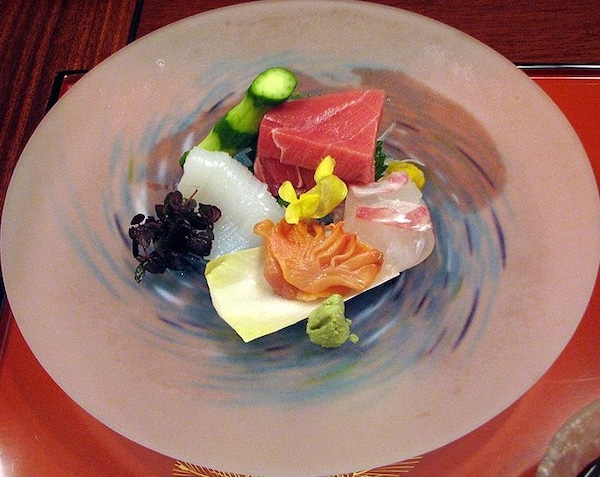
https://commons.wikimedia.org/wiki/Category:Sashimi#/media/File:Jisaku_Kaiseki_Ryori_03.jpg
Red, yellow and green are key colors in Japanese cooking. Getting a nice balance of all three in your presentation will make the food look appealing and bright.
https://commons.wikimedia.org/wiki/Category:Sashimi#/media/File:Bowl_of_sashimi,_in_osaka.JPG
In addition, a triangular (three-sided) composition on the plate looks nice and catches the eye. Think about how sashimi is served. It’s usually bolstered up with a bit of shredded daikon radish and laid out like a little mountain. And around your little mountain, try to keep about 30 percent empty space on the plate. If the plate is too loaded up, the diner will feel full just looking at it, subduing their appetite. Choose serving dishes based on the amount you’ve made, leaving room for that open space.
2. There are courses, of course
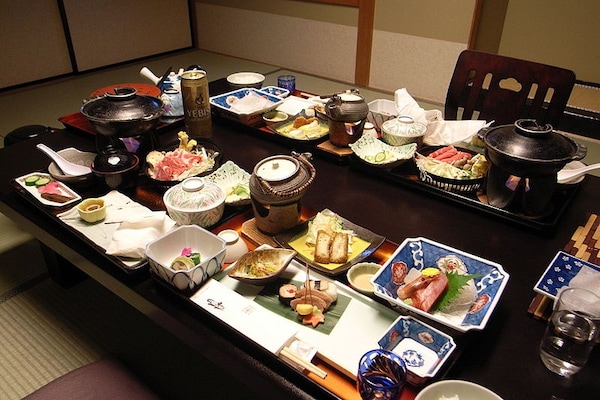
https://commons.wikimedia.org/wiki/Category:Hotel_meals_in_Japan#/media/File:Dinner_at_Kinugawa_Plaza_Hotel.jpg
Just as in many Western cooking traditions, washoku has traditional courses or items that should be included in a meal. One is aemono: chopped vegetables, fish or shellfish with sauce, usually miso-based. This side dish should be served not just to the side of the main, but on its own small plate.
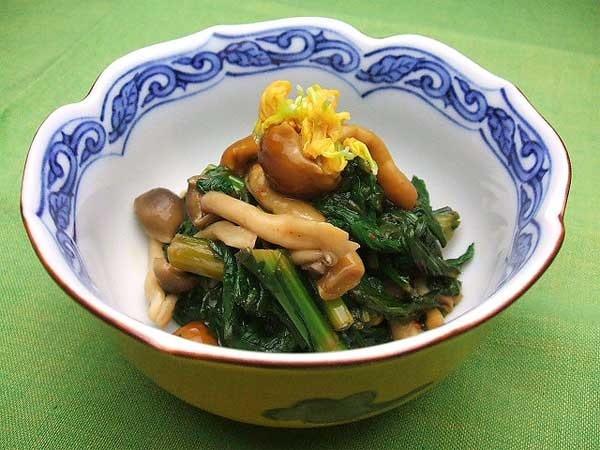
http://en.rocketnews24.com/2014/01/09/japanese-food-presentation-pro-tips-on-making-dishes-you-can-devour-with-your-eyes-and-mouth/
The most pleasing-to-the-eye presentation for aemono is also a little mountain, often with a tiny garnish on top like a slip of lemon peel. To get this presentation to hold, you’ll want to chop your ingredients into bite-sized pieces, and try to get fairly uniform sizes even if you're using several different ingredients.
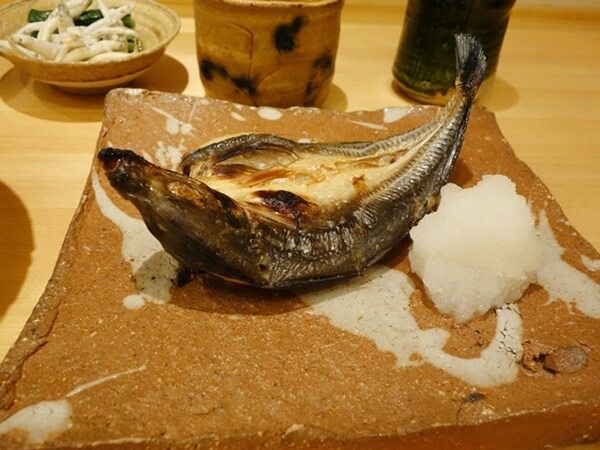
The side dish that actually goes beside the main is called soemono , or supplement. It’s something that is meant as a topping or to be eaten in the same mouthful. A good example is the grated daikon radish that often accompanies grilled fish. Soemono should go on the same plate as the food it accompanies, but to the right of it. This is because most Japanese people are right-handed, so it makes it easier to pick up the soemono and place it on the main.
3. Match your presentation to your plate

Going back to the rule of threes, you may have seen rectangular plates with three “compartments” in them at Japanese restaurants. These are a popular way of serving small nibbles. Not only does it look nice and balanced, it keeps the three items separate, making for a neat presentation without too much fuss. Even without the special dish, evenly spaced groups of three on a long plate look great with the small portions used in Japanese cooking.
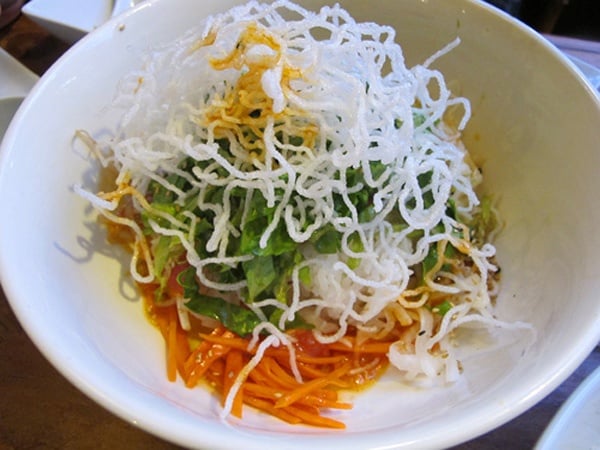
If you're using a big bowl, try to get your dish mounded in the center, with lots of room around the edges to garnish. Think of the bowl as a kind of miniature garden or terrarium and make it look pretty.

https://commons.wikimedia.org/wiki/File:Kenchinjiru_Yoshinoya_D%26C_2007.jpg
When it comes to soup, like the ever-popular miso soup, it's served individually in small bowls about the size of your cupped hands. Don’t fill it up to the brim though. Not only is that messy, it just doesn’t look nice. About 60 percent full is a good rule of thumb. There you go! With those tips and some washoku recipes, you’ll be cranking out beautiful Japanese meals in no time. Happy cooking! Related Stories: Grated radish art from Japan brings the cute to your favourite dishes How to make okonomiyaki at home Vegetables are smarter than fruits: Three high IQ Japanese veggies
Read full story: en.rocketnews24.com

This website uses cookies.

30 Essential Things to Know About Japanese Food Culture
As in many cultures, food in Japan is not merely nourishment but a way of life and an integral part of the nation’s identity. And so, if you want to get to know Japan better, it wouldn’t be wrong to start with its food culture.
With ramen , sushi , sake , matcha, and bento becoming commonplace in many parts of the world, interest in Japanese food is also increasing. But Japanese food culture ( shoku bunka ), in particular the customs surrounding it, is as confusing as it is fascinating.

Fret not. This article will shed light on the many facets of Japanese food culture — not just the traditional rules but also the history, the unique flavors, the aesthetics, and the trends. Ready? Itadakimasu!
Table of Contents
History of Japanese food
Japanese food culture history is very much a part of Japan’s long and colorful past. Here, we look at how this cuisine evolved and yet remained ingrained in the Japanese identity.
1. Prehistoric Japanese chefs likely cooked seafood.

The discovery of ceramic vessels or fragments from sites dating between 11,200 years and 15,300 years ago suggests that pottery was used for cooking in the Jomon period.
Jomon people were hunter-gatherers who lived in Japan during the final phases of the last ice age. They enjoyed a diversity of natural resources: seafood in spring and early summer, deer and wild boar in the winter, and fruits and seeds in the fall.
Samples taken from the ancient pottery showed that pots had been used to cook freshwater and seawater creatures like fish, shellfish, and marine mammals. And millenniums later, seafood is still at the heart of the Japanese food culture!
2. But the Japanese diet was once vegetarian.

It may be hard to believe but the fish-eating nation of Japan used to subsist on rice, soup, and seasonal vegetables.
During the Yamato period, the Chinese introduced Buddhism and in 675 AD, Emperor Temmu banned the consumption of cattle, horse, dog, monkey, or chicken meat. During the Nara period, Empress Koken went a step further and banned fishing.
This ban ended in the Heian period. However, meat and fish were still rare up until the Meiji period, with most Japanese only eating fish on special occasions.
3. Sake is one of the oldest Japanese beverages.

No one knows when exactly sake , also known as nihonshu , came to be. But like many enduring dishes and beverages in Japan , it’s said that the production of rice sake was introduced by the Chinese, a practice that dates back to the 3 rd century.
The drink, brewed from rice, water, yeast, and koji mold, became popular in the Nara period. It can be drunk either hot or cold. At one point, it was even fermented with human saliva , after being chewed and spat out. But don’t worry, the regular sake you’ll see in izakayas (Japanese pubs) aren’t made that way.
4. Tea is steeped in history.

For those who want to stay sober, tea is a popular choice in Japan. Brought in by a Japanese Buddhist monk from China more than 1,000 years ago, green tea was the drink of nobility.
The tea ceremony using matcha (powdered green tea leaves) became part of religious rituals in Buddhist monasteries before the Kamakura Shogunate got wind of the interesting drink. Soon, matcha became a status symbol among the warrior class, so expensive that only monks and samurai could afford it.
Fortunately, matcha and other types of Japanese tea are easy to find and quite affordable these days.
5. Japanese cuisine flourished in the Edo period.
The Edo period (1603-1868) was the golden era in the history of Japanese cuisine. As Edo (present-day Tokyo) grew into a global megacity, people from all over the country came and brought with them a variety of regional cuisine and gave birth to a culinary fusion.
Some of the dishes that prospered during this time were sushi, tempura, unagi no kabayaki (grilled eel), and soba noodles — the earliest fast foods of Japan served at small stalls called yatai. Mirin (rice wine used in Japanese cooking) also took its place in traditional recipes.
6. Umami was coined over a hundred years ago.

Perhaps the most defining aspect in the Japanese food culture we know today is umami , one of the five basic tastes.
Scientifically defined as the taste of salts (e.g., glutamate, inosinate, monosodium glutamate), umami is often described as a meaty, savory, broth-like taste and can be found in a variety of ingredients.
But while only recognized as a scientific term in 1985, the term umami was coined in 1908 by Japanese scientist and professor Kikunae Ikeda. Then in 2002, scientists finally identified umami taste receptors on the human tongue.
Japanese cuisine basics, staples, and customs
Curious about Japanese eating habits and customs, common ingredients and dishes, and more Japanese food culture traditions? Read on!
7. Washoku is Japan’s holistic approach to food.

Washoku , or traditional Japanese cuisine, is more than just Japanese food itself. A dietary culture based on respecting nature, washoku has been registered as a UNESCO Intangible Cultural Heritage.
The Japanese spirit of respecting nature is the building block of what the Japanese eat, how they process and cook what they eat, and how they eat. Some notable features of washoku include:
- Five cooking methods that carefully use ingredients without any waste
- Indulging the five tastes and five senses
- Using five colors (red, yellow, blue/green, white, and black) in preparation and plating
- Using fresh, seasonal, and nutritious ingredients with minimal seasonings
- Observing etiquette and showing appreciation before and after eating
- Celebrating annual events with special foods
Like I said, food in Japan goes beyond sustenance.
8. A typical Japanese meal is called ichiju sansai.

The basic form of washoku is a balanced diet based on ichiju sansai or “one soup, three dishes”.
This core format of Japanese eating culture is composed of the four elements — rice, soup, main and side dishes, and pickled vegetables:
- Gohan – a bowl of plain steamed rice
- Shiru – a bowl of soup, which may contain vegetables or tofu. The most common soup is miso soup.
- Okazu – main dish and two side dishes composed of vegetables, tofu, fish, or meat
- Kouno mono – a small plate of pickled seasonal vegetables
Rice and pickled vegetables are mainstays so ichiju sansai only refers to shiru and okazu. This meal format is followed in home-cooked breakfast, lunch, or dinner. Of course, different rules apply to sushi, ramen, and other non-traditional dishes.
9. Soba and udon are the OG noodles of Japan.

Rice may be at the core of traditional Japanese food culture but noodles play an important role, too. And no, despite the sweeping ramen culture that Japan is known for, ramen is not originally from Japan.
Japan’s traditional noodles are in fact soba and udon. Soba, the thin, grayish-brown noodles, are made from buckwheat flour. It’s usually served cold with a dipping sauce, sliced green onions, and wasabi.
Udon, on the other hand, is made from wheat flour and is thicker than soba. Udon noodles are typically served hot, but occasionally served chilled in the summer. Usual toppings include a raw egg or deep-fried tofu.
10. Dashi is the secret to that umami flavor.

Umami can be found in many ingredients but it takes special cooking techniques to bring out this flavor. And for the Japanese, the key to bringing out umami is through dashi or stock.
Dashi commonly uses kombu (kelp seaweed) and katsuobushi (dried bonito flakes) but sometimes, niboshi (small dried fish) and shiitake mushrooms are also used. These ingredients are soaked in boiling or near-boiling water to produce the base for many sauces, seasonings, and soups in Japanese cooking.
11. Special annual events always include celebratory dishes.

No celebration in Japan is complete without food. Japanese food culture is closely tied to religious events and annual celebrations, with special food and drinks provided not just for people but for gods.
Here are some of the traditional Japanese dishes prepared for holidays and special events:
- Osechi-ryouri – a combination of special dishes packed into jyubako (lacquered boxes). Each dish is believed to bring good fortune, happiness, and good health.
- One soup and three dishes with whole grilled sea bream – traditional Japanese meal prepared for Okuizome held on the 100 th day after a child’s birth
- Toshikoshi soba – eaten every New Year’s Eve. Out of all Japanese noodles, soba is said to break the easiest and by eating it before the New Year comes, you can break off all the bad luck.
- Sekihan (red rice) – often eaten at different celebratory events. The color red is believed to ward off evil spirits.
- Kashiwa-mochi – rice cakes wrapped up in oak leaves together with ingredients like sweet red bean paste. This is usually consumed during Tango no Sekku (Boys’ Day), an event where people wish for boys to grow up healthily.
Japanese food preparation and presentation
Part of what makes Japanese food culture unique is the attention given to cooking and presentation techniques. It’s not enough to have fresh and delicious ingredients — they also have to be cooked well and presented in a visually appealing way.
12. There are five cooking methods in Japanese cuisine.
Japanese cooking can be categorized into five traditional cooking techniques or goho :
- Nama – cutting. Often seen in sashimi (raw fish).
- Niru – simmering or submerging ingredients into hot dashi, water, or liquid seasonings
- Yaku – grilling
- Musu – steaming
- Ageru – deep-frying in high temperatures for a short amount of time without any loss of flavor
A way to enjoy all five cooking methods in one seating is through a standard Kaiseki -style cuisine, Japan’s traditional course dinner.
13. Chefs in training are not allowed to handle the fish or meat for years.

In Japan, the title of head chef is revered and prestigious. This is especially true for sushi chefs. But it takes years of training to earn this respect and recognition. And I mean years.
A sushi chef-in-training may start at the absolute bottom, learning how to hold a knife correctly. After years of doing this and helping with other kitchen tasks, he is given the chance to prepare sushi rice. If the head chef is satisfied, the apprentice may start helping with the preparation of fresh ingredients.
It’s no exaggeration to say that it can take upwards of 10 years of training to be a sushi chef and be allowed to stand in front of the cutting board.
14. Japanese dining culture emphasizes harmony.

Japanese food doesn’t just taste and smell good. By using goshiki (five colors) in preparation and plating, the food stimulates the appetite, evokes a refreshed and clean feeling, and ultimately becomes visually appealing.
Japanese food itself is art. But to further elevate the dining aesthetics, artisanal tableware is used. Plates and bowls may contain seasonal designs like sparrows for spring, morning glory flowers for summer, autumn leaves for fall, and snowflakes for winter.
However, more than the ornate pieces, creating balance and harmony in table arrangement is what’s valuable in Japanese food culture.
15. Portion size is not big…
But it’s not too small either.

A common misconception about Japanese food is the serving size. Most of us think that the portions are incredibly small. While sushi and sashimi come in small portions, most Japanese meals are relatively generous.
Of course, when you compare it to serving sizes in Western countries, Japanese meals appear small. But remember, traditional Japanese meals come with soup, rice, and three dishes! And they are usually filling enough.
Japanese dining etiquette
Japanese food etiquette is both an important and tricky subject. While you won’t get kicked out of a restaurant for committing a faux pas, practicing politeness and proper etiquette will make for a more enjoyable experience for you and your eating companions.
16. Knowing a bit of the lingo helps.

There are a couple of Japanese phrases you can say during meal times to show your appreciation for the food.
The first one is itadakimasu , which translates to “Let’s eat!” and is said before a meal. Saying this phrase expresses gratitude to all the people who worked to make the meal happen — from the people who grew the ingredients to the people who cooked and prepared the food.
The second phrase is goshisou sama deshita or the more casual goshisou sama literally means “What a feast!” This is a way to say “Thank you for the food” or “What a great meal!” after eating. It’s also an expression of gratitude towards the ingredients — life forms that were converted into food to give us energy.
17. Seating arrangement matters…
Unless you’re with friends. But if you’re in a formal setting, like a business dinner or dining at an elderly’s home, it’s good to know traditional seating arrangements.
There is always an “honored seat” called the kamiza. This is reserved for the guest-of-honor, the highest-ranking person in the table, or the oldest. It is usually the seat at the corner of the room farthest from the entrance. If there is a tokonoma or alcove in the room, the kamiza is in front of it.
Meanwhile, the lowest ranking guest or the youngest in the group sits in the shimoza , the seat nearest to the entrance. Why? Because this allows for more room to order, move around to pass food, or pour drinks for the higher ranking or older guests.
18. Use wet towels only to wipe your hands.

In Japanese restaurant culture, wet towels or oshibori are often provided to clean your hands before eating. This may come in the form of wet disposable paper tissues or reusable cloth towels.
Whichever type of oshibori you receive, this is given specifically for wiping your hands and nothing else. You may see others using it to wipe their face, mouth, or even the table, but it’s not considered to be good manners.
19. Slurping is okay but not all sounds are.

Ah, slurping. A common subject of confusion when it comes to Japanese food etiquette.
To be clear, unlike in many countries, slurping is common in Japan and even expected to a certain extent. Noodles are often served hot and slurping is done to cool them down while eating.
That said, slurping is not mandatory. And while it’s acceptable, other sounds aren’t. The noise made when setting down tableware, chewing or munching sounds, blowing your nose, burping — all of these are considered bad manners in Japan.
20. Use chopsticks the right way.

Another delicate matter in Japanese food culture is the use of chopsticks, the main utensil in Japanese dining.
The proper way to hold chopsticks is to first hold the upper chopstick like you would a pencil with your grip sitting at the top third of the sticks. The second chopstick sits on your ring finger and is held with the base of your thumb. You should be able to move the top chopstick up and down to grip food.
Other things to remember when using chopsticks include the following:
- Don’t use your bowl as a resting place for your chopsticks. If no chopstick rest is available, use the wrapper or paper binding that your chopsticks came in.
- Don’t stab food with your chopsticks.
- When having soup, use the chopsticks to eat the solid items from the broth. Then, bring the bowl to your mouth and drink the broth from it.
If you’re having difficulty using chopsticks, you’re better off requesting a fork and knife. Remember, however, that certain dishes like sushi and sashimi are not meant to be eaten with a fork and it would be rude to do so.
21. There are proper ways of eating sushi.

Preparing quality sushi requires years of training and the best ingredients. That’s why you’re expected to show respect and gratitude to the sushi chef by observing good manners.
We’ve covered common sushi etiquette and customs here , but it’s worth mentioning again that sushi is traditionally eaten by hand, not by chopsticks, so as not to ruin its perfect form. Nigiri sushi is also meant to be eaten in one bite.
22. And correct ways of eating ramen.

As is with sushi, you’re also expected to observe etiquette when eating ramen.
For instance, you’re expected to start with a few sips of the broth before slurping the noodles or putting in any additional seasoning. And it’s meant to be eaten fast!
You can educate yourself further with this list of ramen etiquette and customs .
23. Don’t pour yourself a drink.

Compared to ramen shops and sushi restaurants, izakayas or Japanese pubs are less uptight when it comes to table manners. However, there are still certain things to observe, especially when drinking with Japanese people.
When drinking alcoholic beverages, don’t pour your own drink. Instead, it’s customary to serve others and refill their drinks if their cups are getting empty. Likewise, you should let others serve you more alcohol.
Additionally, you should hold your drink until everyone has one and say “ kampai! ”, meaning “cheers”, in unison.
24. Eating while walking is frowned upon.

In many countries, it’s not uncommon to see people grabbing a bite from a sandwich or bagel while rushing to the office or heading to the next sightseeing spot. In Japan, it’s considered rude.
While there’s no law forbidding you to do so, it is requested to avoid doing this for a couple of reasons. First, it goes against the Japanese food culture of appreciating your food properly. Plus, eating while walking also produces litter and attracts unwelcome wildlife.
When buying food from a convenience store, vending machine, or a street stall, it’s best to eat it at the store itself or in front of it. You can also eat it at home or on a bench where you can finish your meal.
25. Tipping is not recommended.

Something interesting for penny-pinching tourists: tipping is not customary in Japan. In fact, in some cases, it may even be considered rude.
Japanese culture values hard work and dignity, making good service a standard rather than something special. This is especially true for Japanese restaurants. You may even be chased down by the restaurant staff to give back any money you left behind.
That said, tour guides and taxi drivers may sometimes accept tips. In general, however, saying thank you and being polite to people you encounter is enough.
Japanese food in contemporary times
Traditional Japanese food culture offers glimpses into Japan’s illustrious past but Japanese ingenuity is just as visible in the more recent (or reinvented) culinary developments.
26. Not all bento boxes are created equal.

Another popular Japanese invention, a bento is a portable meal of rice and side dishes packed into a small container. Historically, bento boxes were used by Japanese farmers, hunters, and warriors who needed food while working outside.
Today, however, there are several types of bento boxes made for different settings, such as:
- Shidashi – bento delivered by professional caterers and are usually ordered for important occasions.
- Shokado – Developed in Osaka at the beginning of the Showa period, it has four types of dishes, arranged into four sections of a lacquered bento box. It’s essentially kaiseki in a box.
- Ekiben – bento found in many railroad stations
- Kamameshi (potted rice) – home-style bento traditionally cooked and served in an earthenware pot
- Koraku – large bento boxes meant to be shared among a small group
- Kyaraben – “character bento” or lunchboxes made for children, often shaped or designed to look like cartoon characters
27. Convenience wins in modern Japanese cuisine.

Convenience stores and vending machines did not originate from Japan but the Japanese have made it their own.
The first convenience store or konbini in Japan opened in 1973 and stores have since hosted a plethora of items ranging from edible to bizarre. Carrying bento boxes, instant ramen, sandwiches, salads, Japanese snacks , and drinks, convenience stores offer a quick and relatively cheap way to fill up one’s tummy.
Too busy to even visit a convenience store? A quick and tasty snack or drink from a vending machine is the way to go. Japan has the highest number of vending machines per capita. These machines contain a dizzying array of products – chips, soda, coffee, dessert, edible insects, and even love letters !
28. Japan loves food delivery.

Interestingly, the concept of food delivery or demae has existed in Japan for centuries. It started over 300 years ago during the Edo period and continued to thrive during the Showa era.
Food delivery was done via bicycles, with drivers delivering more than 20 dishes each time. But with the emergence of cars, balancing stacks of dishes on bicycles became dangerous. Boxes to hold food behind bicycles and motorcycles were then created.
Food delivery remains popular in modern-day Japan, especially with the rise of fast food and smartphones. Popular food delivery companies include UberEats, Food Panda, and Maishoku and you can order pretty much anything — sushi, bento boxes, pizza, Japanese curry, ramen, donburi, and more!
29. They also love Western food… with a twist.

Speaking of pizza, the Japanese also eat and love food from the other side of the planet. But while hamburgers, fish and chips, and pasta are present in Japan, there is a type of Western cuisine that is unique to Japan — the Yoshoku.
Yoshoku is Western cuisine, reinvented the Japanese way. Make no mistake, this isn’t simply fusion food, but a distinctly Japanese adaptation of Western dishes.
Popular yoshoku dishes include:
- Kareraisu or curry rice (curry was introduced to Japan by the British)
- Hambagu or hamburger but served with rice, salad, and sauce
- Napolitan, spaghetti (with the consistency of udon) stir-fried with vegetables and meat, seasoned with ketchup
- Doria , baked casserole, similar to a French gratin
30. Street food in Japan is not as common.

Known as yatai , street food stands have been around since the Edo period. They provided the earliest forms of fast food and were commonly seen as part of Japanese nightlife culture. They were also more common in festivals or matsuri.
However, in the 1900s, stricter regulations made it difficult to open and run a yatai. They were frowned upon and thought of as unsightly eating spots that created litter and invited noise. Soon, the number of street food stalls declined.
The good news is, Japanese street food culture is seeing a resurgence after the relaxation of yatai laws. More chefs are also experimenting with street food and the influx of young tourists helps popularize this eating experience.
What’s next?
To know the food of a place is to know its culture. If you read this until the end, you definitely know about Japanese food more than you ever did!
But this list barely scratches the surface. For the Japanophile foodie, there is more to learn. I recommend reading your way through these Japanese food facts , exploring the nitty-gritty of sushi and ramen , satisfying your sweet tooth with Japanese candies and chocolates , and finishing it off with a Japanese beverage !
Leave a Comment Cancel reply
Save my name, email, and website in this browser for the next time I comment.

© 2024 Hey Explorer
Stock images by Depositphotos
Inside Kyoto
A Kyoto Travel Guide
Kaiseki: A Complete Guide to Japan’s Haute Cuisine
Kaiseki is one of the world’s most refined cuisines. For a serious foodie, no trip to Japan would be complete without at least one proper kaiseki meal. Here’s our full guide to kaiseki, along with some recommended places in Kyoto to try it.

Introduction to Kaiseki
Kaiseki is said to date back to the 16th century, when tea master Sen-no-Rikyu introduced an austere version of the cuisine to accompany the tea ceremony. In practice, modern kaiseki is actually a style of cooking and food presentation that evolved over the last few centuries, bringing together a wide variety of high-end cooking techniques, presentation methods and ingredients. The best description of kaiseki is simply “Japanese haute cuisine,” that is, elegant food eaten on special occasions.

The most important thing to note about kaiseki is that the food is only one part of the experience. In this regard, kaiseki is like the tea ceremony, in which tea is only one element of an all-encompassing aesthetic experience. In kaiseki, first and foremost, dishes are chosen to reflect the season: ingredients are always “shun-no-mono,” or the freshest and best the market has to offer. And each course is served on carefully chosen tableware like lacquerware trays and priceless ceramic bowls. Finally, tremendous thought goes into how each dish is presented, so that every course resembles an edible work of art.

And, the aesthetic concerns don’t end at the table: the room in which the meal is served is equally important. Good kaiseki is almost always served in a traditional restaurant decorated in a refined and simple manner. The flowers and scroll in the tokonoma (sacred alcove of the room) will be carefully chosen to reflect the season. And, ideally, one side of the room will have a sliding glass door allowing a view over a perfect little tsubo-niwa (Japanese pocket garden).

As with all things Japanese, there is always layer upon layer of meaning. Certain foods might actually serve as culinary puns or references to obscure classical works of poetry or history. Of course, most of this will be lost on the average foreign diner. But, don’t feel too bad about that: they’ll also go flying over the heads of all but the most educated Japanese diners.
Since kaiseki is a traditional style of Japanese cuisine, you’ll find lots of seafood and shellfish, plenty of vegetables, and the all-important rice, usually served with miso soup and tsukemono (Japanese pickles) at the end of the meal. And, of course, the drink of choice is sake, but you can also ask for beer or oolong tea.

The Courses of Kaiseki
A full-course kaiseki dinner will consist of anywhere from 7 to 14 courses, usually served in a strictly prescribed order. The names of each course might differ from place to place, but here’s a pretty typical course, which we recently enjoyed at Tawaraya Ryokan in Kyoto. Occasionally, some of the courses will be served together on the same tray, rather than one at a time, which is common at stand-alone restaurants.
Shokuzen-shu (aperitif)
The meal will often start with a small glass of liqueur, often ume-shu (plum wine) or similar.

Saki-zuke (starter)
The next course is the saki-zuke, which serves as an amuse-bouche to stimulate the appetite. Here, we were served shrimp and ebi-imo (a type of Japanese potato).

Ko-suimono (small soup course)
The next course will be ko-suimono or just suimono. This is a soup course. Here, the soup was pureed lotus root with roasted pine nuts.

Muko-zuke (sashimi course)
The next course will be muko-zuke, or the sashimi course. Here, it was kue (long-tailed grouper) and fugu (puffer fish).

Mushi-mono (steamed food course)
After sashimi, you’ll be served a mushi-mono, or steamed dish. In this case, we were served conger eel, clams, yuba, shimeji mushroom, mitsuba (Japanese parsley) steam-boiled in an earthenware teapot. On the side was a type of Japanese citrus called sudachi.

Yaki-mono (grilled fish course)
The next course, yaki-mono, is the grilled fish course. At Tawaraya, this included ayu (sweetfish), nameko mushroom, conger eel, citrus-grilled shrimp, and roasted ginko nuts.

Atsu-mono (hot dish)
The next course is atsu-mono (literally, hot dish). We were served simmered duck meat and small turnips. This is often the “main course” of a kaiseki meal.

Shii-zakana (side dish)
The next course is called shii-zakana, which is a side dish. In our case, it was shijimi clams served with yuba, myoga and sesame seeds.

Gohan (rice)
The next course is gohan (the Japanese word for rice). To the Japanese, a meal is not a meal unless it includes rice. And, rice is always served with miso soup (in this case, a high-end miso called aka-dashi) and some tsukemono (Japanese pickles). This being Tawaraya, the rice, aka-dashi and tsukemono were among the best I’d ever tasted.

Mizu-mono (dessert)
The final course is mizu-mono (literally, water thing). The word water is used because the dessert is often fruit. In our case, we were served pear compote with blueberry sauce.

How Much Does Kaiseki Cost?
A full-course kaiseki dinner at a good Kyoto kaiseki restaurant will cost between Y10,000 and Y30,000 per person without drinks. There are some cheaper places, but you generally get what you pay for.
How to Reserve a Kaiseki Restaurant
Needless to say, you can’t just walk into a kaiseki restaurant and expect to be served, especially at dinner. So, here’s what you do: Get the concierge at your hotel or ryokan to call ahead and make the booking for you.
How to Dress for Kaiseki
Needless to say, kaiseki is not the kind of meal you’d want to eat wearing shorts and flip-flops. But, you’d don’t have to dress formally either. Smart casual will be perfectly fine. But, please wear decent socks. You’ll almost certainly have to remove your shoes when you enter the restaurant, and nothing looks worse than a couple of hairy toes protruding from an old pair of socks.
Kaiseki on the Cheap
One good way to sample kaiseki without breaking the bank is to go at lunch, when some restaurants serve a variety of their classic dishes in an elegant lacquerware bento box for as little as Y3,000 per person.

Kyoto’s Best Kaiseki Restaurants
Kitcho arashiyama honten.
( Arashiyama ; expensive) Kitcho Arashiyama is considered by many in Japan to be the best kaiseki restaurant in the country.
( Southern Higashiyama ; expensive) This three-star Michelin restaurant has a beautiful location just around the corner from Maruyama-koen Park, so it’s very convenient. And, the food is awesome.

Kikunoi Roan
( Southern Higashiyama ; mid-range to expensive) The sister restaurant of the above place, this is more approachable and more reasonable, and the food is still superb.

Guilo Guilo Hitoshina
( Downtown Kyoto ; mid-range) Located downtown, along a picturesque canal, Guilo Guilo Hitoshina offers a delicious, modern take on kaiseki cuisine at affordable prices.


Gion Owatari
( Southern Higashiyama ; expensive) 2-star kaiseki restaurant Gion Owatari is a favourite with Japanese gourmands, and no wonder – the cooking here is at once soulful and impeccable.

Kiyamachi Sakuragawa
( Downtown Kyoto ; expensive) Kiyamachi Sakuragawa is an approachable and superb spot to enter the world of kaiseki cuisine.
More Kyoto Restaurant Information
- Best Kyoto Restaurants
- Best Kyoto Vegetarian Restaurants
- Vegan Kyoto
- Gluten-Free Kyoto
Kyoto Vacation Checklist
- For all the essentials in a brief overview, see my First Time In Kyoto guide
- Check Kyoto accommodation availability on Booking.com and Agoda.com - often you can book with no upfront payment and free cancellation
- You can buy shinkansen (bullet train) tickets online from Klook - popular routes include Tokyo to Kyoto , Kyoto to Osaka and Kyoto to Tokyo
- Need tips on where to stay? See my one page guide Where To Stay In Kyoto
- See my comprehensive Packing List For Japan
- Buy a data-only SIM card online for collection when you arrive at Kansai International Airport (for Osaka and Kyoto) or Tokyo's Narita Airport . Or rent an unlimited data pocket wifi router
- Compare Japan flight prices and timings to find the best deals
- If you're making frequent train journeys during your visit, you might save money with Japan Rail Pass – see if it's worth it for you
- A prepaid Welcome Suica card makes travelling around Kyoto easy – here's how
- World Nomads offers simple and flexible travel insurance. Buy at home or while traveling and claim online from anywhere in the world
Kyoto District Map

- Central Kyoto
- Northwest Kyoto
- Northern Higashiyama
- Southern Higashiyama
- Downtown Kyoto
- Kyoto Station Area
- South East Kyoto
Disclosure: InsideKyoto.com is a participant in the Amazon Services LLC Associates Program, an affiliate advertising program designed to provide a means for sites to earn advertising fees by advertising and linking to amazon.com and amazon.co.uk. World Nomads provides travel insurance for travellers in over 100 countries. As an affiliate, we receive a fee when you get a quote from World Nomads using this link. We do not represent World Nomads. This is information only and not a recommendation to buy travel insurance.
Moments Log
Blogging every moment of your life
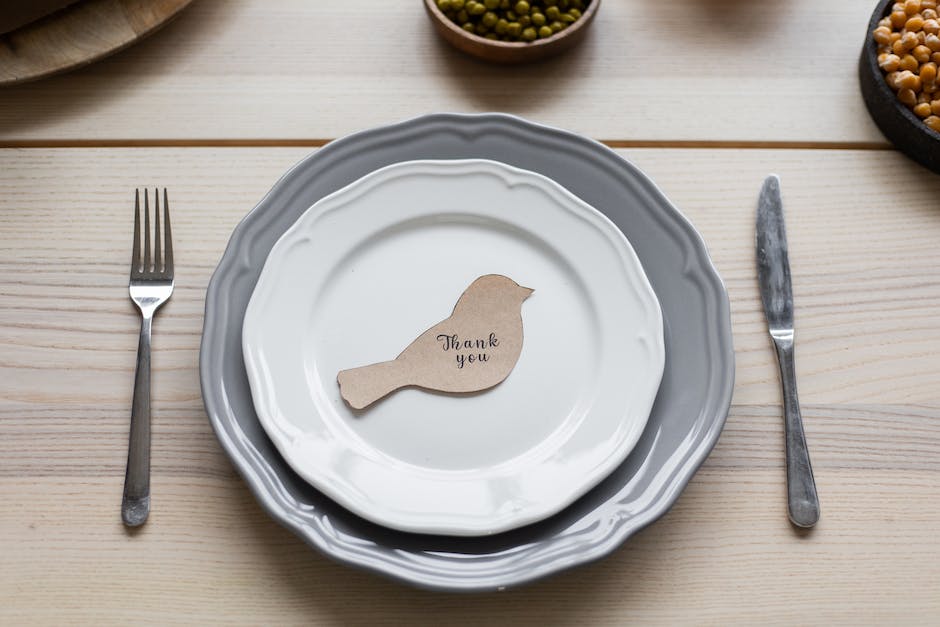
The Art of Food Presentation: Mastering Plating Techniques from Around the World
Table of contents.
Japanese Food Presentation: The Art of Minimalism and Balance
French Cuisine: Elevating Dishes with Elegant Plating Techniques
Fusion plating: combining cultural influences for stunning presentations.
Unleash your culinary creativity with The Art of Food Presentation : Mastering Plating Techniques from Around the World .
When it comes to food presentation, the Japanese have truly mastered the art of minimalism and balance. Japanese cuisine is not only known for its exquisite flavors but also for its visually appealing presentation. Every dish is carefully crafted to create a harmonious balance of colors, textures, and shapes. In this article, we will explore the techniques and principles behind Japanese food presentation and how you can incorporate them into your own culinary creations.
One of the key principles of Japanese food presentation is the concept of “less is more.” Unlike other cuisines that may focus on elaborate garnishes and decorations, Japanese dishes are often simple and understated. The emphasis is on the natural beauty of the ingredients themselves. This minimalist approach allows the flavors to shine through and creates a sense of tranquility and elegance on the plate.
Another important aspect of Japanese food presentation is the use of negative space. Empty spaces on the plate are just as important as the food itself. This creates a sense of balance and allows the eye to rest, enhancing the overall visual appeal of the dish. The arrangement of the food is carefully considered, with each element placed with intention and precision.
In addition to negative space, the use of color is also crucial in Japanese food presentation. Traditional Japanese cuisine often incorporates a variety of vibrant colors, ranging from the deep green of matcha to the bright red of tuna sashimi. These colors not only add visual interest but also represent different flavors and textures. The careful selection and arrangement of ingredients create a visually stunning and appetizing display.
Texture is another element that plays a significant role in Japanese food presentation. A variety of textures, such as crispy, soft, and chewy, are often incorporated into a single dish. This creates a dynamic and enjoyable eating experience. The contrast in textures adds depth and complexity to the overall presentation, making each bite a delight for the senses.
Japanese food presentation also pays great attention to the shape and size of the ingredients. Each component is meticulously cut and arranged to create a visually pleasing composition. The use of different shapes, such as squares, circles, and triangles, adds visual interest and creates a sense of harmony. The size of the ingredients is also carefully considered to ensure that each bite is balanced and enjoyable.
To achieve the art of Japanese food presentation, it is essential to have the right tools. Traditional Japanese knives, such as the yanagiba and usuba, are designed specifically for precision cutting and slicing. These knives allow chefs to create clean and precise cuts, enhancing the overall presentation of the dish. Additionally, Japanese ceramic plates and bowls are often used to showcase the food, as they provide a beautiful backdrop for the vibrant colors and textures.
In conclusion, Japanese food presentation is a true art form that emphasizes minimalism, balance, and harmony. By incorporating the principles and techniques of Japanese cuisine into your own cooking, you can elevate your dishes to a whole new level. Remember to focus on simplicity, negative space, color, texture, and shape. With practice and attention to detail, you too can master the art of Japanese food presentation and create visually stunning and delicious meals.

When it comes to the art of food presentation, French cuisine has long been revered for its elegant and sophisticated plating techniques. From Michelin-starred restaurants to quaint bistros, French chefs have mastered the art of creating visually stunning dishes that are as pleasing to the eye as they are to the palate.
One of the key principles of French plating is the concept of balance. French chefs strive to create a harmonious composition on the plate, using a combination of colors, textures, and shapes to create a visually appealing dish. This attention to detail is what sets French cuisine apart and elevates it to a level of culinary artistry.
One classic French plating technique is known as “à la française,” which involves arranging the main protein, such as a perfectly cooked piece of fish or meat, at the center of the plate. The protein is then surrounded by carefully arranged vegetables, sauces, and garnishes, creating a visually striking presentation. This technique not only showcases the main ingredient but also allows for a variety of flavors and textures to be enjoyed in each bite.
Another popular French plating technique is known as “à la minute,” which translates to “in the moment.” This technique involves cooking and plating the dish just before it is served, ensuring that it is presented at its peak freshness and flavor. This attention to detail is what makes French cuisine so special and is a testament to the dedication and skill of French chefs.
French chefs also pay great attention to the use of color in their plating. They understand that vibrant and contrasting colors can make a dish more visually appealing. For example, a bright green herb sauce drizzled over a perfectly seared piece of meat can create a striking contrast that immediately catches the eye. Similarly, a colorful array of fresh vegetables can add depth and visual interest to a dish.
In addition to color, French chefs also use texture to enhance the visual appeal of their dishes. They understand that a variety of textures can create a more interesting and enjoyable dining experience. For example, a crispy exterior paired with a tender interior can create a delightful contrast that adds excitement to each bite. French chefs often achieve this by incorporating elements such as crispy breadcrumbs, creamy sauces, and crunchy vegetables into their dishes.
Lastly, French chefs understand the importance of simplicity in plating. They believe that less is often more and that a dish should not be overwhelmed with unnecessary elements. Instead, they focus on highlighting the natural flavors and beauty of the ingredients. This minimalist approach allows the flavors to shine through and creates a sense of elegance and refinement on the plate.
In conclusion, French cuisine is renowned for its elegant and sophisticated plating techniques. French chefs have mastered the art of creating visually stunning dishes that are as pleasing to the eye as they are to the palate. Through careful attention to balance, color, texture, and simplicity, French chefs elevate their dishes to a level of culinary artistry that is truly awe-inspiring. Whether dining in a Michelin-starred restaurant or a cozy bistro, experiencing the art of French plating is a feast for the senses.
Food presentation is an essential aspect of culinary art that can elevate a dish from ordinary to extraordinary. Plating techniques from around the world offer a myriad of possibilities for chefs to create stunning presentations that not only please the palate but also captivate the eyes. One such technique that has gained popularity in recent years is fusion plating, which involves combining cultural influences to create visually striking dishes.
Fusion plating is a creative approach that allows chefs to blend different culinary traditions, flavors, and aesthetics to produce unique and visually appealing presentations. By combining elements from various cultures, chefs can create dishes that tell a story and offer a multi-sensory experience to diners.
One example of fusion plating is the combination of Japanese and French techniques. Japanese cuisine is known for its emphasis on simplicity, balance, and the use of fresh ingredients, while French cuisine is renowned for its intricate techniques and rich flavors. By merging these two culinary traditions, chefs can create dishes that showcase the best of both worlds.
For instance, a chef might use the delicate art of sushi rolling to create a visually stunning dish, but instead of traditional Japanese ingredients, they might incorporate French flavors such as foie gras or truffle. The result is a fusion dish that combines the elegance of Japanese presentation with the indulgence of French cuisine.
Another example of fusion plating is the combination of Mediterranean and Asian influences. Mediterranean cuisine is characterized by its vibrant colors, fresh ingredients, and bold flavors, while Asian cuisine is known for its intricate knife work and attention to detail. By blending these two culinary styles, chefs can create dishes that are visually striking and bursting with flavor.
For example, a chef might use the technique of spiralizing vegetables, a popular trend in Mediterranean cuisine, to create a visually appealing base for a dish. They might then incorporate Asian flavors such as soy sauce, ginger, and sesame oil to add depth and complexity to the dish. The result is a fusion dish that combines the freshness of Mediterranean ingredients with the umami flavors of Asian cuisine.
Fusion plating also offers an opportunity for chefs to experiment with different textures and temperatures. By combining contrasting elements, such as crispy and creamy or hot and cold, chefs can create dishes that offer a delightful sensory experience.
For example, a chef might pair a crispy tempura shrimp with a creamy avocado puree and top it off with a refreshing citrus salsa. The contrast between the crispy shrimp, smooth puree, and tangy salsa creates a dish that not only looks visually appealing but also offers a variety of textures and flavors.
In conclusion, fusion plating is a creative approach that allows chefs to combine cultural influences to create visually stunning dishes. By blending different culinary traditions, flavors, and aesthetics, chefs can create dishes that tell a story and offer a multi-sensory experience to diners. Whether it's the combination of Japanese and French techniques or the fusion of Mediterranean and Asian influences, fusion plating offers endless possibilities for chefs to showcase their creativity and mastery of the art of food presentation. So next time you dine out, keep an eye out for fusion dishes that not only taste amazing but also look like works of art on your plate.
Share this:
Japan's Traditional Food Styles
- Published on : 25/12/2012
- by : Japan Experience
- Add to favorites
Japan's Traditional Food Styles: read an article on Japan's traditional food styles including kaiseki ryori and shojin ryori.
Japanese Court Food
Food for the samurai.
- Tea Ceremony
- Kaiseki ryori
- Shojin ryori
- Japanese Food
Japan's Traditional Food Styles 懐石料理
by Alan J. Wiren
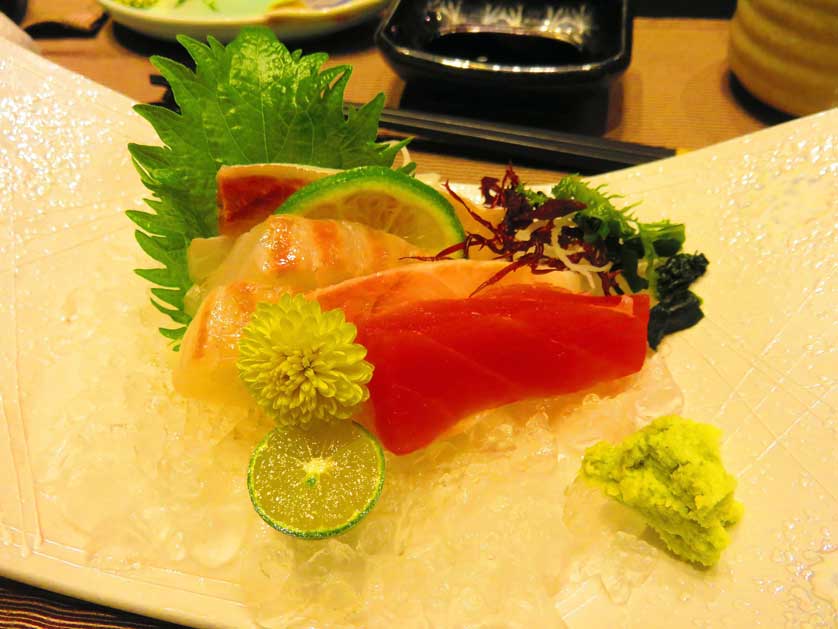
A visitor to Japan can expect a wealth of enjoyment from her traditional food. The presentation and flavors alone are a delight, but understanding the origins of what is at the end of your chopsticks can give a deeper appreciation of the food and a greater understanding of the society that brought it there.
Looking back one thousand years you would see tribute flowing, from all parts of the nation, to Kyoto , the ancient capital; to the emperor, the ultimate power.
Fish, rice, salt, and firewood traveled over well established routes to the palace kitchens where they met with local ingredients to become the sustenance the imperial court.
The food was served, to those fortunate enough to be members or guests, on trays with four short legs, called zen. A meal could comprise several courses and each diner would receive one zen for each course. Each course consisted of several dishes.
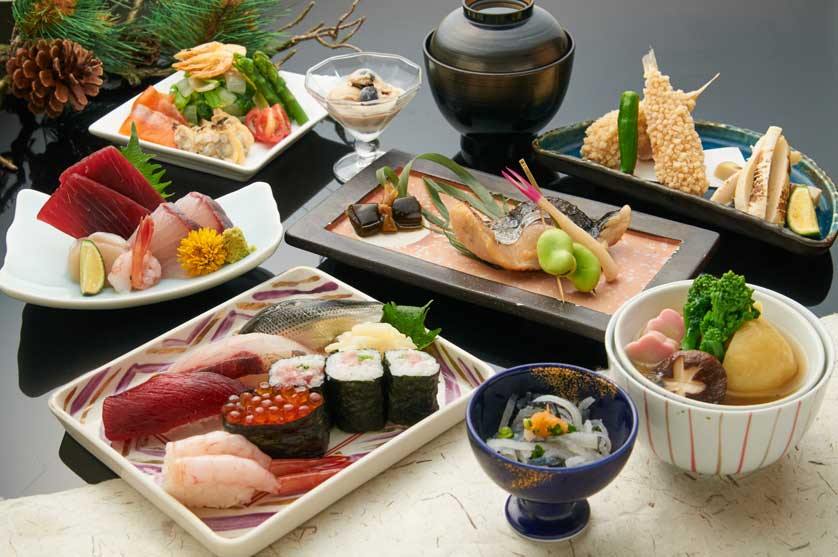
It might seem to go without saying that, as in modern times, the focus of these courtly meals was flavor and nutrition, but those are not universal objectives in food history, and in Japan, times were about to change. The ninth to the twelfth centuries saw a shift in power. The emperor gradually became a figurehead and real power was taken by the samurai class.
What happens to food between the field and table has, throughout history , paralleled the development of the social classes for whom it is destined. The substance of Japan's imperial banquets transformed along with the political climate. Court meals became affairs meant more to impress, than to nourish. Trays were filled with more food than could be eaten in a sitting, with many dishes meant to be appreciated with the eye rather than with any other organ.
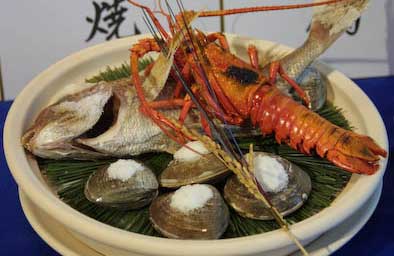
Meanwhile, the samurai had come to power from the peasant class. Theirs was a vastly different lifestyle from the imperial family's that made for meals without frills, often without flatware. While people of the court used spoons, the food of the common people was served in bowls and eaten with hands. Chopsticks would not appear until later. As their wealth and power increased, some samurai did begin to adopt the court banquet style, but when the military government was officially established and the first Shogun took office in the thirteenth century, those who had were punished.
Although the Spartanism, delineating shogunate from court, would not last, differences at the table that distinguished their social classes would flourish. As the samurai became more firmly established, and built palaces of their own in Kyoto, two different schools of cooking grew up alongside the two branches of government. The Shijou school was for nobility and the Ouska school was for samurai. Both were ostentatious, and served their elaborate fare on the four-legged trays that give this style the name of honzen ryori. As time went on, they would create more and more elaborate rules of food preparation that distinguished one from the other.
In time, the shogunate, lost their power of rule to the lords who governed their lands, but his did nothing to hinder the trend toward flaunting wealth and social status at dinnertime. This nearly completes the backdrop against which a very different, and perhaps the most well known, style of Japanese cuisine was about to appear. Only one more element is needed.
Japanese Tea Ceremony
By the sixteenth century, tea had become a popular drink among Japan's nobility and samurai. The samurai often practiced tea drinking as a kind of competition. Samples were served to banquet guests, and the contest was to identify them by tasting. Such games were often followed by much appreciation of sake . At this time a man appeared who would open a new chapter in food history: a Buddhist monk who would become tea master to two of the three military leaders who reunified Japan under the rule of the Shogunate. His name was Sen No Rikyu.
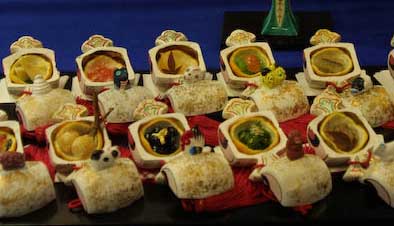
It was Rikyu who crystallized the form of the Japanese tea ceremony. A contrast to the embellished banquets of the upper classes, his was the way of simplicity and harmony: harmony between the guests, and with the natural world around them. Rikyu was respectful of the powerful effect that tea was considered to have on both body and mind, and to mollify it he prescribed a light meal an essential part of the ceremony. The philosophy behind that meal still survives in the kaiseki ryori style of dining.
Kaiseki Ryori
In this context, it is easy to see why the name kaiseki was chosen. It refers to a warm (kai) stone (seki) that monks would slip into their robes, against their bellies to ward off hunger pangs during devotions. Rikyu's ideal repast was one that did not call attention to itself, rather it was integral to a heightened appreciation of the moment.
Nowadays service called honzen and kaiseki can be had in Japan's restaurants, but since Rikyu's day times have continued to change, and both of these food styles have changed with them. Perhaps the greatest influence was the evolution of the restaurant, itself. It wasn't until nearly a century after Rikyu's death that food service outside the Japanese home moved from the teahouses and inns that provided refreshment along the roads for those obliged to travel, into the cities.
When it came to serving honzen and kaiseki ryori the new restaurateurs were faced with challenges. When the honzen style was served in a restaurant, economic pressure dictated that the fare must not be only visually aesthetic, but nourish the diner, as well. In the case of kaiseki few customers would pay the inflated costs of restaurant dining only to be presented with Rikyu's charming, but austere ideal.
The main influence of restaurants on honzen and kaiseki ryori has been to make them more similar to each other. While honzen became more practical, kaiseki became more presentation oriented. What still distinguishes them is that honzen is still a banquet style meal, with small courses that follow one after the other, some prepared with elaborate technique, while kaiseki is still a selection and presentation in harmony with the natural world. If you really want to experience the kaiseki ryori of Rikyu's day, look for cha-kaiseki.
Shoujin Ryori
One style of Japanese food presentation that has remained relatively untouched by time is shoujin ryori. Shoujin can be translated as "devotional" because this is the style that has been handed down in Buddhist monasteries and temples through hundreds of years. Of course it is strictly vegetarian, but the lack of meat by no means makes it dull. It is also a style in harmony with the seasons, and accommodates variety and ingenuity that make this kind of meal an entertainment on its own.
Another constant in the history of traditional Japanese food is the city of Kyoto. While the seat of the nation's political power has shifted multiple times, Kyoto has remained a living repository for the styles that comprise her culinary past and present. Kyoto's Nanzenji Temple is famous for offering shoujin ryori, and has a tradition of doing so for the last three hundred years. While Kyoto hosts countless restaurants that offer some interpretation of the kaiseki style, Yamabana Heihachi Jaya, next to the river Takanogawa, has a history nearly as long as the city's own, and serves meals in both the honzen and kaiseki styles.
Yamabana Heihachi Jaya is a five minute by taxi ride from the Kitayama Subway Station. See their website for directions.
Nanzenji is on the Tozai Subway Line. From Keage Station, cross the street and go through a brick-lined tunnel. The temple is a 10 minute walk in the same direction.
Text and Photos by Alan Wiren
Other Japan articles by Alan Wiren
Books on japan & japanese food, latest articles.
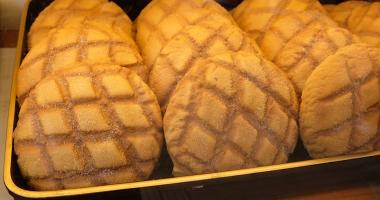
Street food in Asakusa: Indulge in culture and cuisine
One of the most iconic locations in Eastern Tokyo is Asakusa, largely cited as the main hub of Tokyo’s “Shitamachi.” Shitamachi refers to one of the two major historic districts of Tokyo, and the n
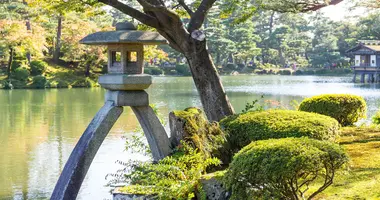
The Food Specialties to try in the Japanese Alps
Within the literal heart of Japan exist a series of mountain ranges that bisect the main island of Honshu.
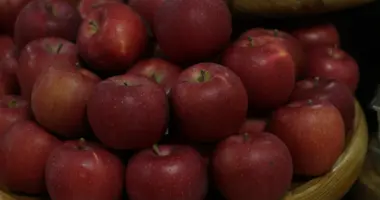
The food specialities to try in Tohoku
Bridging Japan’s major hub of Kanto and the most northern island of Hokkaido, the Tohoku region boasts some of the main island of Honshu’s most celebrated attractions, its unique culinary culture e
All the themes of the city
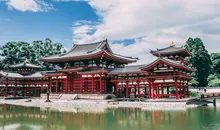
Travelling in Japan: a comprehensive guide

Books on Japan

Japanese Movies

Japanese Language

Japanese History
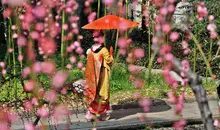
Understanding Japan

Before you Travel
Please select your country on the list below:
- Switzerland
- United Kingdom
- Other countries
Your browser is outdated
Please upgrade to a more modern version to fully experience JapanToday site and for security reasons

- Real estate
- Classifieds

Japanese food presentation: Tips on making dishes you can devour with your eyes and mouth
Japanese food has been gaining in popularity all over the world, and with the induction of traditional Japanese cooking, or "washoku," as a UNESCO Intangible Cultural Heritage, locals are expecting interest to rise further.
If you’d like to branch out a bit from your usual sushi rolls and try your hand at some "washoku" recipes, not only taste but also presentation is key. We’ve collected a handful of simple tips from the pros on how to make your Japanese cooking look as good as it tastes.
Keep in mind the three rules of threes
Red, yellow and green are key colors in Japanese cooking. Getting a nice balance of all three in your presentation will make the food look appealing and bright.
In addition, a triangular (three-sided) composition on the plate looks nice and catches the eye. Think about how sashimi is served (photo below). It’s usually bolstered up with a bit of shredded daikon radish and laid out like a little mountain.
And around your little mountain, try to keep about 30% empty space on the plate. If the plate is too loaded up, the diner will feel full just looking at it, subduing their appetite. Choose serving dishes based on the amount you’ve made, leaving room for that open space.
There are courses, of course
Just as in many Western cooking traditions, "washoku" has traditional courses or items that should be included in a meal. One is "aemono," chopped vegetables, fish or shellfish with sauce, usually miso-based. This side dish should be served not just to the side of the main, but on it’s own small plate.
The most pleasing-to-the-eye presentation for "aemono" is also a little mountain, often with a tiny garnish on top like a slip of lemon peel. To get this presentation to hold, you’ll want to chop your ingredients into bite-size pieces, and try to get fairly uniform sizes even if you are using several different ingredients.
The side dish that actually goes beside the main is called "soemono," or supplement. It’s something that is meant as a topping or to be eaten in the same mouthful. A good example is the grated daikon radish that often accompanies grilled fish.
"Soemono" should go on the same plate as the food they accompany, but to the right of it. This is because most Japanese are right-handed, so it makes it easier to pick up the "soemono" and place it on the main.
Match your presentation to your plate
Going back to the rule of threes, you may have seen rectangular plates with three “compartments” in them at Japanese restaurants. These are a popular way of serving small nibbles. Not only does it look nice and balanced, it keeps the three items separate, making for a neat presentation without too much fuss. Even without the special dish, evenly spaced groups of three on a long plate look great with the small portions used in Japanese cooking.
If you are using a big bowl, try to get your dish mounded in the center, with lots of room around the edges to garnish. Think of the bowl as a kind of miniature garden or terrarium and make it look pretty.
When it comes to soup, like the ever popular miso soup, it is served individually in small bowls about the size of your cupped hands. Don’t fill it up to the brim though. Not only is that messy, it just doesn’t look nice. About 60% full is a good rule of thumb.
There you go. With those tips and some "washoku" recipes, you’ll be cranking out beautiful Japanese meals in no time. Happy cooking!
Source: Naver Matome
Read more stories from RocketNews24. -- Chef shares his cooking secret -- How to make a depressed daikon snowman -- School Lunch in Japan

A must-buy product at Don Quijote!
See what's trending at Don Quijote in Japan and why you should get them!

Teach English in Japan
Join the leaders of English Education for Children in Japan!
1 Comment Login to comment
Maria Jan. 15, 2014 12:59 pm JST
Well, despite myself, I found this interesting. Lots of psychology involved.
Login to leave a comment
Facebook users.
Use your Facebook account to login or register with JapanToday. By doing so, you will also receive an email inviting you to receive our news alerts.
Login with your JapanToday account
Articles, offers & useful resources.
A mix of what's trending on our other sites

5 Cold Ramen Dishes for the Sweltering Japanese Summer
GaijinPot Blog
- Skip to main content
- Skip to after header navigation
- Skip to site footer

L’Academie de Cuisine
The Ultimate Culinary Experience
Cuisines Home » Asian Cuisines » Japanese Food: 35 Exquisite and Traditional Dishes to Sample
"We hope you love the products we recommend! When you buy through links on Lacademie.com, We may earn an affiliate commission. Affiliate Disclosure "
Japanese Food: 35 Exquisite and Traditional Dishes to Sample
Japanese foods always leave a deep impression in the mind of diners due to their incredible flavor. Therefore, do not miss any chance to try them if you have a chance to visit Japan. And I am sure you will fall in love with these signatures immediately.
One of the hallmarks of Japanese cuisine is its focus on the quality of ingredients, presentation, and the use of seasonal foods. Therefore, Japanese recipes have not only an incredible taste but also an eye-catching appearance.
So follow me to explore more about the beauty of this cuisine!
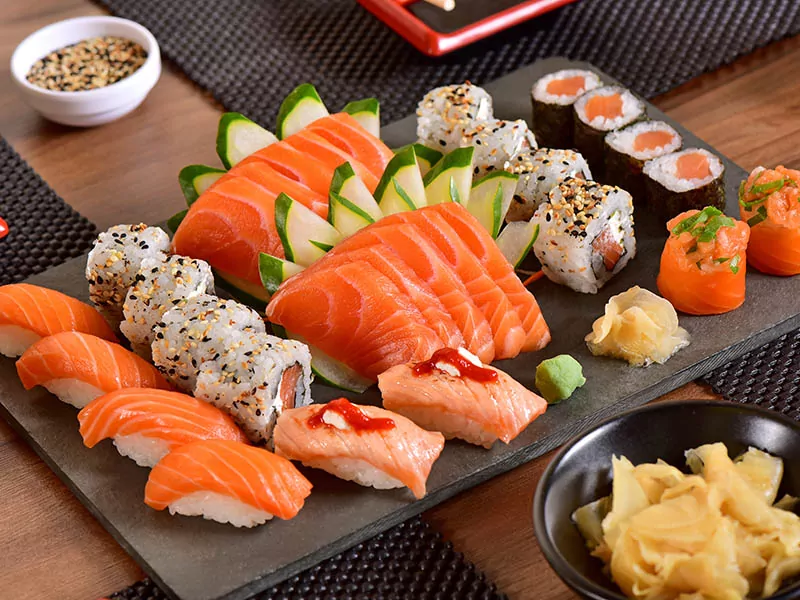
The Overview Of Japanese Cuisine
First, let’s have a quick glance at some factors that feature the culinary culture of Japan.
- Presentation
The presentation of dishes is a key element of Japanese cuisine. Japanese chefs not only make their dishes taste delicious but also delightful to the eye.
Many dishes follow the minimalist style, with a focus on simplicity and elegance in presentation.
Japanese chefs also pay close attention to every detail of the dish, from the way the food is cut and arranged to the placement of garnishes and sauces.
- Ingredients
There is a wide array of ingredients that the Japanese love to use in their signature food. However, they emphasize the use of fresh, seasonal ingredients. Here are some popular components in Japanese meals.
- Rice: Rice is a staple of the Japanese diet. People use it in a wide range of dishes, namely sushi, donburi bowls, and onigiri (rice balls).
- Seafood: Japan is surrounded by water and has a long history of fishing, so seafood is a major part of natives’ meals. Common types of seafood used in Japanese cooking include fish (like tuna and salmon), eel, squid, and octopus.
- Soy sauce: Soy sauce is a key condiment in Japanese cuisine. The main purpose of soy sauce is to add flavor to various dishes. It is made from fermented soybeans and has a salty, umami flavor.
- Miso: Miso is another fermented soybean product. It is often used to make soups and marinades, thanks to its rich, savory flavor.
- Vegetables: These plant-based foods are important parts of their diet. Common ones are daikon (Japanese radish), shiitake mushrooms, green onions, and seaweed.
Tofu: Tofu is made from soybeans. Though it is also a plant-based food, it is a popular source of protein in Japanese delicacies that you can normally find in soups, stir-fries, and salads.
This cuisine seeks to achieve balance and harmony in flavors. And umami is a key flavor in Japan’s feasts, which is often achieved through the use of complementary ingredients (e.g., soy sauce, miso, and dashi) and cooking techniques.
Regarding their cooking methods, there are five primary Japanese techniques, such as Raw (namasu), Simmered (nimono), Steamed (mushimono), Grilled (yakimono), Fried (agemono).
- Respect For Tradition And Social Aspect
There is a strong respect for history and tradition in Japanese cooking. Thus, many Japanese recipes are deeply rooted in traditions that have been passed down for generations.
On the other hand, this culinary cuisine often involves communal dining, with shared plates and the opportunity for socializing and bonding over a meal.
- Regional Diversity and Innovation
They have a diverse range of regional cuisines, each with its own unique flavors and specialties.
However, while Japanese cuisine is deeply traditional, there is also a spirit of innovation and experimentation in modern cooking in the country. Chefs are constantly exploring new techniques and ingredients to create new dishes.
Traditional Japan’s Noodle-Based Delights
There are thousands of attractive noodle types in Japanese cuisine . So you should learn about the unique and beautiful flavors of the well-known noodles in the list below to enjoy the essence of Japanese recipes.
And in order to eat these dishes properly, you have to learn how to use a typical East Asian eating utensil – chopsticks since many Japanese foods normally come with these pairs of sticks, particularly noodle delicacies.
- 1. Ramen (Japanese Noodle Dish)
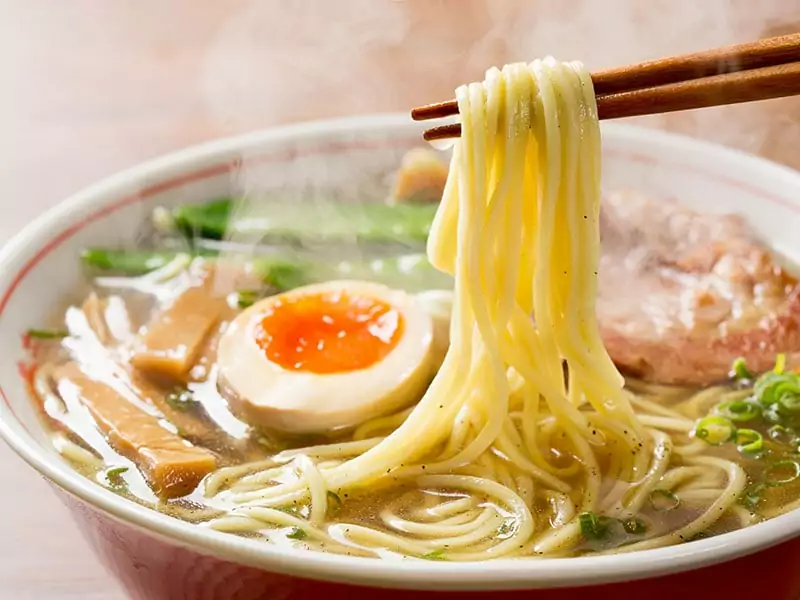
Ramen was originally called “Chinese soba” and was introduced to Japan during the Taisho era. Ramen restaurants began to emerge in the 1900s and have since evolved into numerous ramen variations .
Made primarily with wheat flour, ramen noodles are famous for their satisfying chewiness. A typical bowl of ramen includes pork, seaweed, and eggs, but there are many other toppings to choose from.
Besides perfect ramen noodle varieties , the soup is the soul of the dish, with various flavors and ingredients creating a complex and rich taste. With its delicious taste and comforting warmth, ramen is a must-try Japanese dinner for anyone.
These are all things you need to know about delicious ramen.
- 2. Udon (Japanese Thick Noodles)
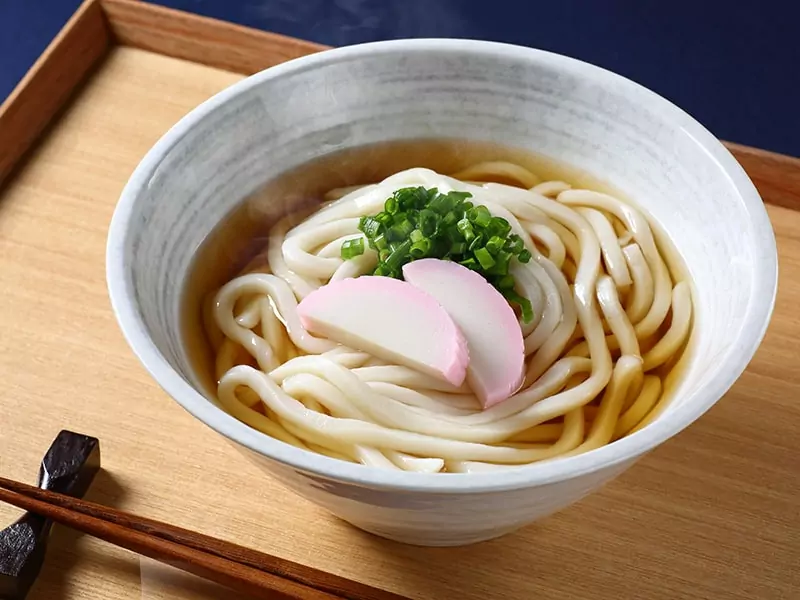
Udon is one of the three most-eaten noodles in Japan, so there is no reason not to try it. Udon noodles with brine wine and wheat flour will have the perfect chewiness and texture.
There are many ways to enjoy this delicious food starting with “U” Japanese people often stir-fry noodles with vegetables or put them in a hot pot. However, the most popular version is udon noodle soups. You will be mesmerized by the sweetness of the broth and the varieties of Udon toppings.
Speaking of its origin, Udon was first created in the 13th century when the monk Enni invented the noodle-making technique. Originally, udon was known as “Konton“, and was a combination of sweet fillings and wheat flour. There are 15 different ways to prepare udon.
Learn the history and the ways to make fantastic Udon noodles.
- 3. Yakisoba (Fried Noodles)
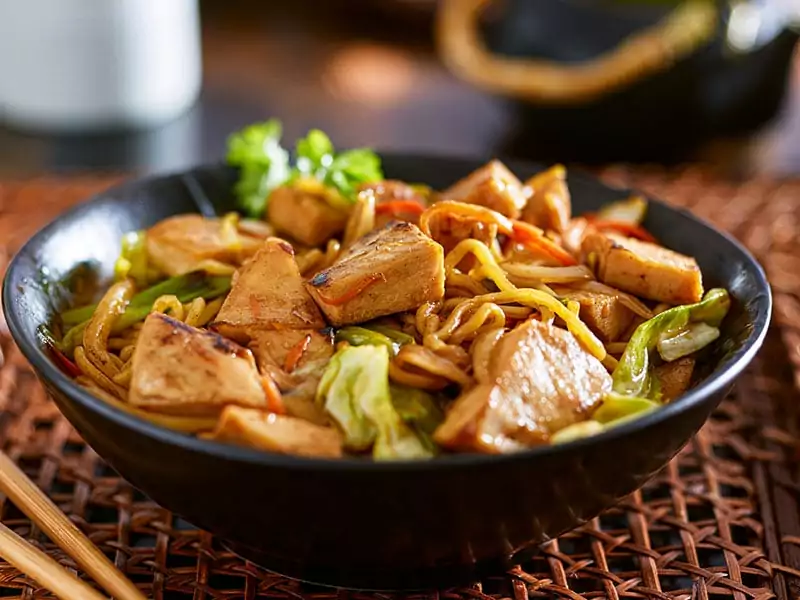
Yakisoba is a popular dish in Japanese noodles that appears in numerous famous Japanese cookbooks. Noodles will be stir-fried with various vegetables and pork. A little yakisoba sauce will make the noodles richer and more attractive. You will be defeated by the deliciousness of the noodles immediately.
In particular, yakisoba is a noodle that is not made from buckwheat. If you have the opportunity to visit Japan during the festivals, you will encounter vendors making noodles outdoors in the bustling atmosphere of the festival.
Besides the famous restaurants around the world with yakisoba, this food beginning with “Y” popularity is also supported by the company Nissin. This is the company that has continuously produced Japanese noodles so that more people can have access to this signature food.
- 4. Soba (Buckwheat Noodles)
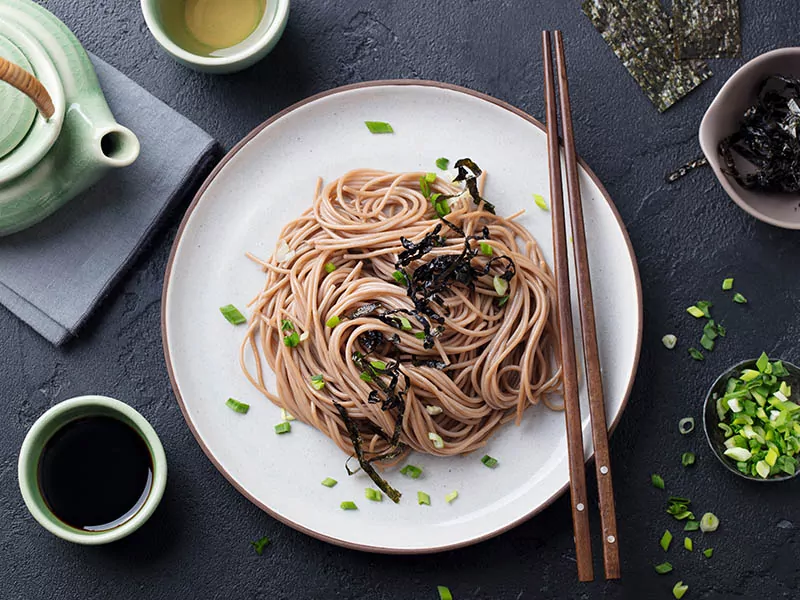
Soba is a type of Japanese noodle made from buckwheat flour. You will be immersed in the characteristic nutty and earthy flavors when eating the chewy and yummy soba noodles.
A bowl of soup typically contains soba noodles, onions, tempura, and fish cake. Another popular soba dish is tempura soba, which is soba noodles served in a hot broth with pieces of tempura (deep-fried seafood or vegetables) on top. The crispy tempura adds a nice texture to the soft noodles and savory broth.
In addition, soba noodles are often eaten with a dipping sauce called tsuyu, which is made from soy sauce, mirin, and dashi broth.
FYI, soba is also known as “breaking off the old year” since the noodles break easily.
Let’s taste soba noodles to understand more about their flavor.
Delicious Japanese Dishes With Meat And Seafood
Japan’s food scene is a paradise for meat and seafood lovers, with an array of beautiful dishes waiting to be discovered. So make sure to jot down these fantastic delights so you can try them while in this country.
- 5. Sashimi (Sliced Raw Fish)
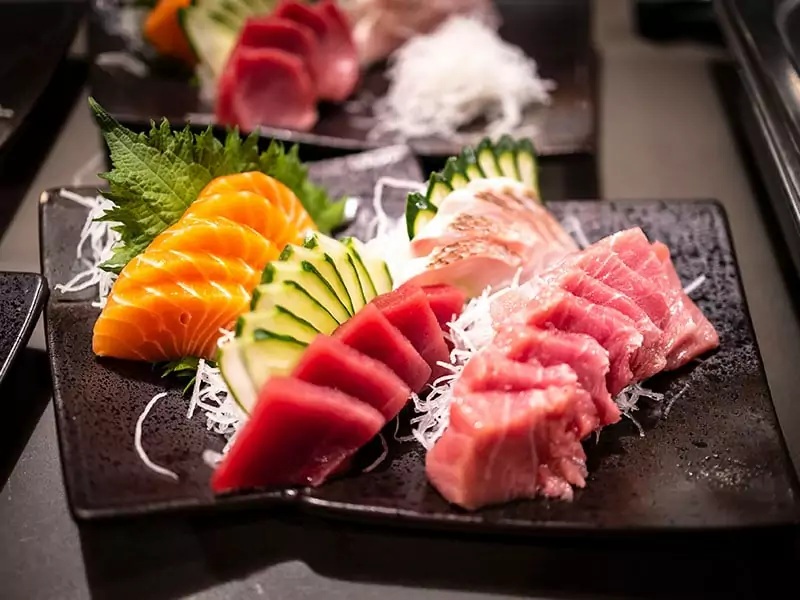
Sashimi is one of the iconic Japanese dishes. You should add this fantastic food to your Japanese lunch recipes during this trip. The slices of fresh fish will make you enjoy the original and most natural seafood taste.
In reality, fish is a major ingredient in Japanese meals. People consume more than 154 pounds of fish per person annually.
These tender and delicious fish slices will bring out their full flavor when accompanied by soy sauce, wasabi, and pickled ginger. You shouldn’t confuse sashimi with sushi, nigiri, or maki , as they’re all vastly different dishes.
A sashimi chef needs to be trained for 10 years before serving sashimi directly at a restaurant. In particular, sashimi is not only fish but also beef, chicken, and raw squid. About 80% of tuna is used for sashimi.
When it comes to the most common and traditional Japanese delight, most of us will think of sushi immediately.
This dish was brought to the Americans in 1868 after the Meiji Restoration. Today, this is considered a symbolic dish of the land of the rising sun and is enjoyed around the world.
A research carried out in Japan in 2022 revealed that sushi was the preferred food choice among Japanese consumers, with nearly 80% of the participants selecting sushi as a favored dish.
The main ingredients of sushi are rice, vinegar, and seafood or other toppings. The rice used in sushi is a short-grain variety and is seasoned with a mixture of vinegar, sugar, and salt.
The seafood used in sushi can include raw fish (e.g., tuna, salmon, or yellowtail) as well as cooked seafood like shrimp, crab, or eel. Vegetables such as cucumber, avocado, or pickled daikon are also common additions.
Sushi is often served with various condiments, including soy sauce, wasabi, and pickled ginger. These simple delights are meant to complement the flavors of the sushi and provide a balance of tastes and textures.
Let’s learn some fantastic facts about sushi.
- 7. Yakitori (Skewered Chicken)
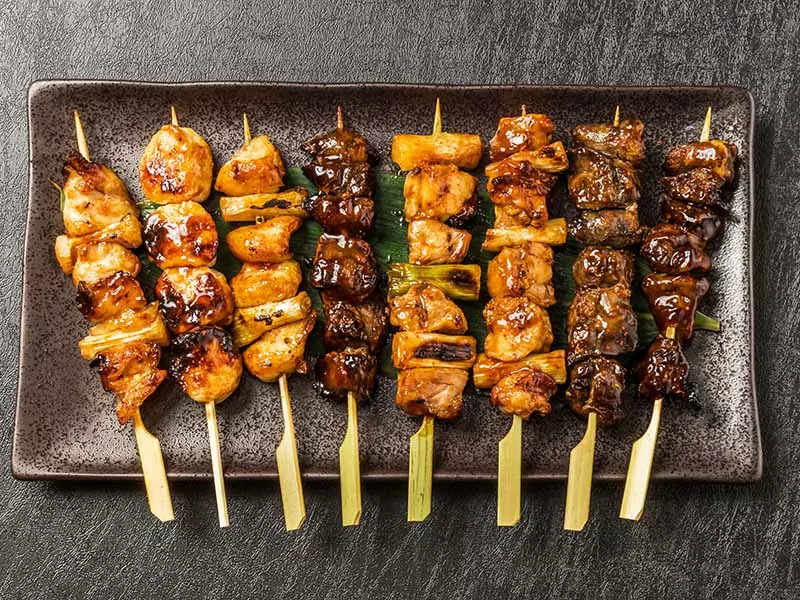
Yakitori is a recipe associated with Japan’s sports matches. This Japanese chicken delicacy is common on most menus of Japanese restaurants. It is usually served pre-cooked, frozen, or canned.
Hotei Foods Corporation was the first company to produce canned yakitori in 1970. It is also sold at street stalls in this country.
The Japanese love to eat these grilled chicken sticks and the bite-sized pieces of yakitori will awaken your taste buds. Plus, the name “yakitori” means “barbecued chicken”.
The sauce on the outside of the chicken pieces is another thing that makes them become a well-loved dish. Nowadays, you can find yakitori sticks with beef, pork, fish, or vegetables. Dipping yakitori in the traditional teriyaki sauce and enjoying it with wine is an incredible experience.
Get these instructions to cut chicken for yakitori.
- 8. Tempura (Deep-Fried Seafood And Vegetables)
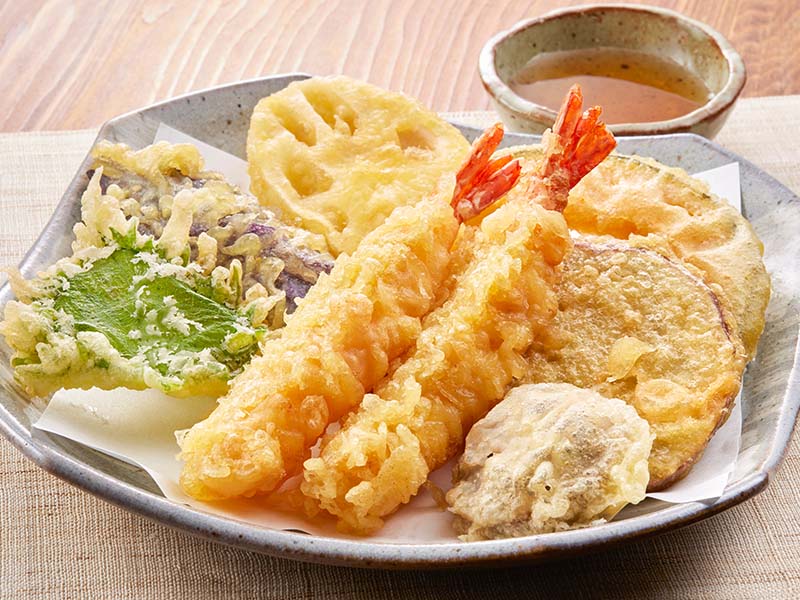
It would be remiss not to mention tempura in this list. If you love crunchy foods, you cannot go wrong with them. Meat, seafood, and vegetables are deep-fried with a layer of tempura batter on the outside.
The eye-catching yellow color of this recipe will captivate you at first sight. You will feel a rustling sound in your mouth when chewing tempura. In Japan, people often eat this food with rice or noodle soups.
Tempura first appeared in Japan in the 1600s when Portuguese missionaries arrived. It was born when they were forbidden to eat meat and it became an indispensable recipe during Lent.
It is time for you to try the crispy tempura in a Japanese restaurant.
- 9. Mentaiko (Salted Alaska Pollock Roe)
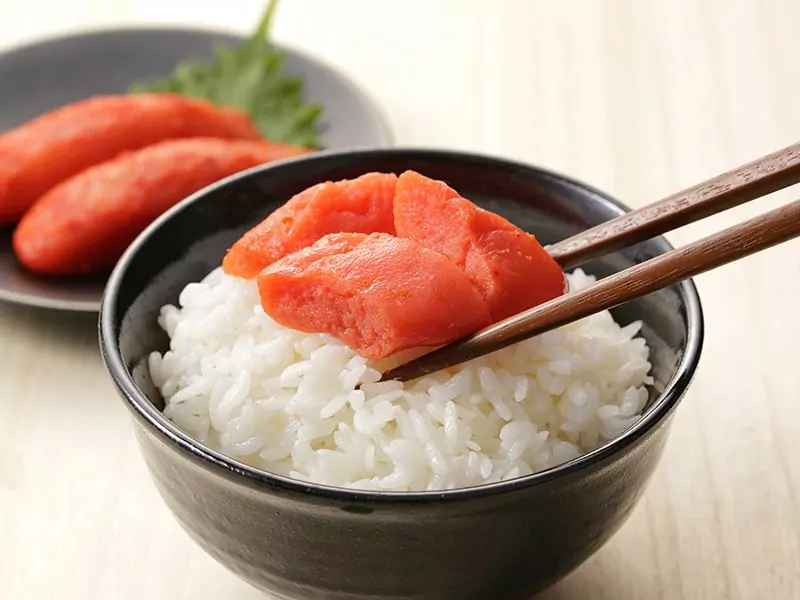
Mentaiko was introduced to Japan from Korea in 1949 by a Japanese named Kawahara Toshio, who lived in Busan. He went through the tasting process of Korean cod roe before introducing it in Japan. You’ll often see it in comparison between Japanese and Korean food .
Mentaiko is a unique gift I would like to dedicate to seafood fans. Pollen eggs will be marinated in salty water to eat with white rice. The version of Karachi mentaiko seasoned with chili peppers is for spicy food lovers.
When eating ramen, you will also have the opportunity to enjoy mentaiko when it is used as a topping of this noodle dish. In addition, it is combined with butter or cream to make a mentaiko sauce to eat with pasta.
- 10. Tonkatsu (Fried Pork Cutlets)
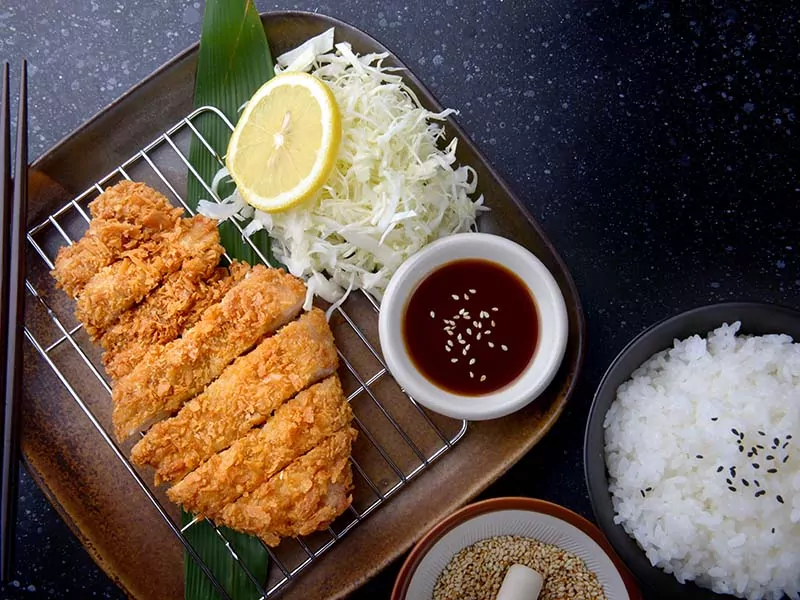
Tonkatsu is a dish made from pork cutlets introduced to Japan by Europeans. The pork pieces are fried in oil with a layer of breadcrumbs covering the outside to give it a perfect crunch and an eye-catching golden brown color.
When ordering tonkatsu at Japanese restaurants, you will be provided with a cup of dipping sauce made with vegetables and delectable Japanese fruits . Moreover, cabbage and salad will make you not bored when consuming these excellent pieces of pork.
Take a trip to Japan to eat mouthwatering tonkatsu.
- 11. Chawanmushi (Egg Custard)
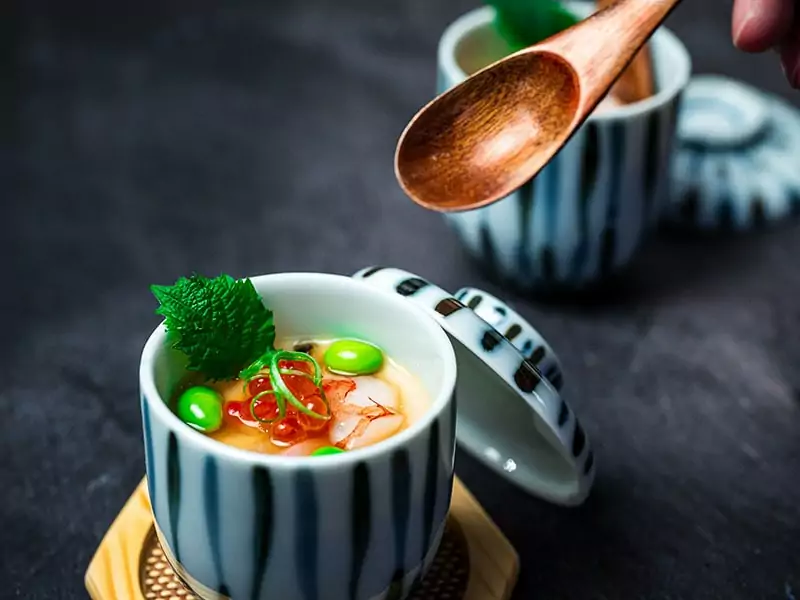
Recharge with a delicious and rich teacup of chawanmushi that will make you feel more comfortable and relaxed after a day of exploring Japan. Eggs will be steamed in a small cup with meats and vegetables after seasoned. People also turn it into a delicious Japanese shrimp dish.
When you eat chawanmushi, you will easily associate it with pudding because of its texture. The name chawanmushi comes from the way it is prepared. “Chawan” means a cup of tea, and “Mushi” means steamed. It was born 300 years ago during the Edo period.
Check out the methods to make soft and fantastic chawanmushi.
- 12. Kaki Fry (Deep-Fried Breaded Oyster)
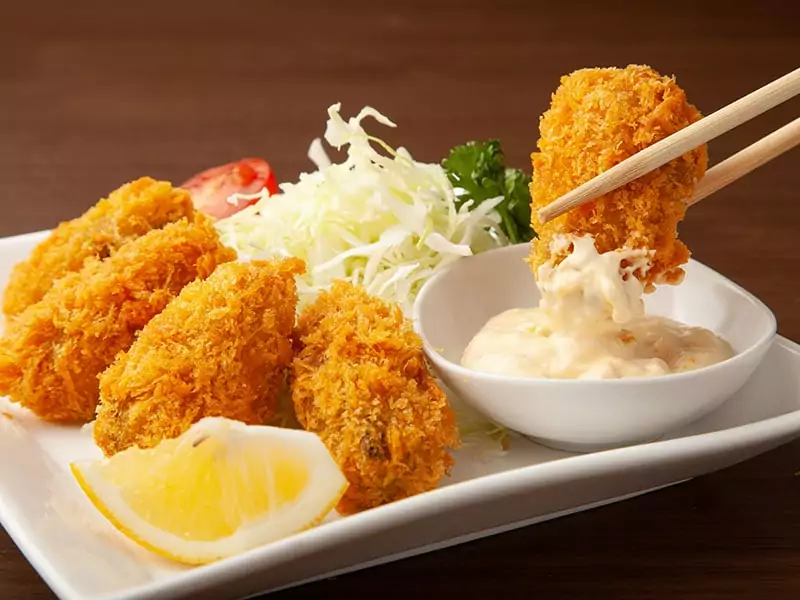
If you love dishes made with oysters, you will love this delicious and beautiful deep-fried oyster. It appeared in Japan in the late Meiji era. Fresh oysters will be coated with flour, beaten eggs, and bread crumbs before becoming crispy in hot oil.
This food is pretty popular in Japan in autumn and winter because these are the two seasons when oysters are most abundant and yummy. Restaurants often serve this fantastic dish with vegetables and various sauces.
- 13. Karaage (Japanese Deep-Fried Meat)
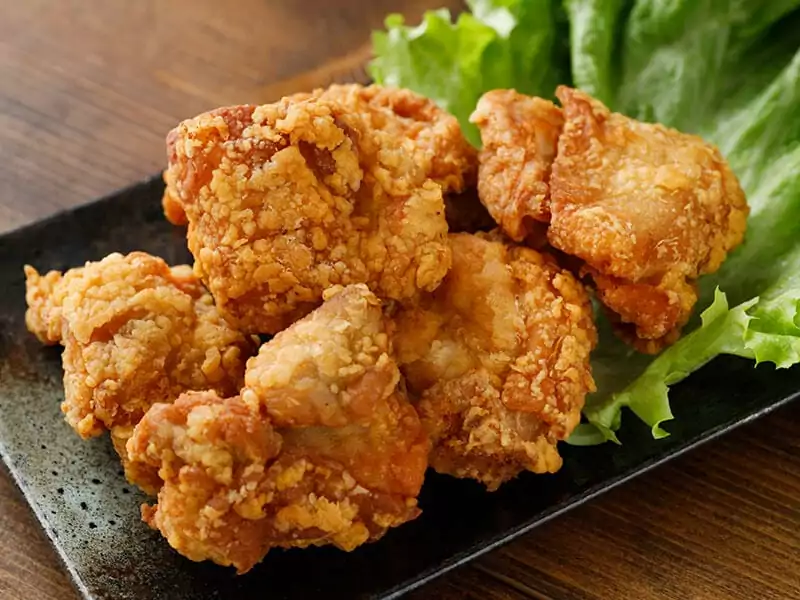
Karaage is another popular Japanese dish that consists of bite-sized pieces of deep-fried meat, typically chicken. The origins of karaage can be traced back to China” and was introduced during the Edo period (1603-1867).
In fact, Karaage refers to a cooking method that you lightly coat pieces of meat in flour before deep-frying in oil. Therefore, many people assume this delicacy is a variation of tempura.
However, the key difference between these two is the ingredient of Karaag typically marinated in a blend of seasonings before being coated in potato starch or cornstarch and deep-fried until crispy and golden brown.
The most commonly-used meat to make Karaage is chicken, but you can find other styles with fish or other meat.
The dish is often served alone as an appetizer or snack. Or you can enjoy it with shredded cabbage or rice.
Yummy Japanese Street Foods You Must Try
If you like the comfort of eating, Japanese street cuisine should be a top choice on your waitlist. It is time to satisfy your cravings with these mouthwatering treats right away.
- 14. Dango (Japanese Dumplings)
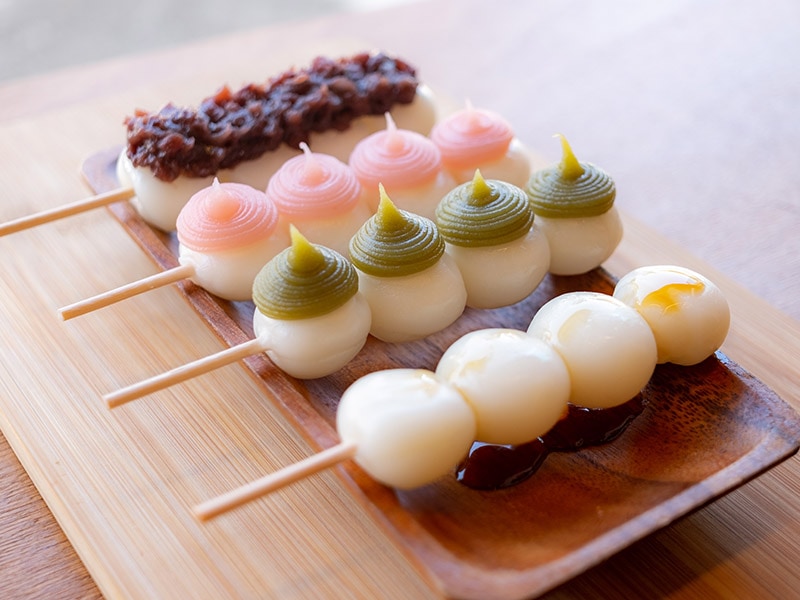
Japanese dessert recipes are varied, but you will need sweet Dango dumplings if you want something to refresh your mouth after enjoying street food.
These irresistible desserts from Asia are usually skewered on sticks with (about 3 to 5 dangos) and sold in every corner of Japan. Round cakes of various colors are made from mochiko (sweet rice flour).
The Japanese will make seasonal dango. In the cherry blossom season, they will make hanami dango with pink colors like these flowers. Plus, if you like matcha (finely ground powder of green tea), Matcha Dango is also a well-loved sweet.
Regarding its history, the first version of dango was first made in the Jomon period from 1400 to 300 BC. The Japanese of this time collected nuts to grind into flour like today’s flour.
- 15. Shioyaki (Grilled And Salted Fish)
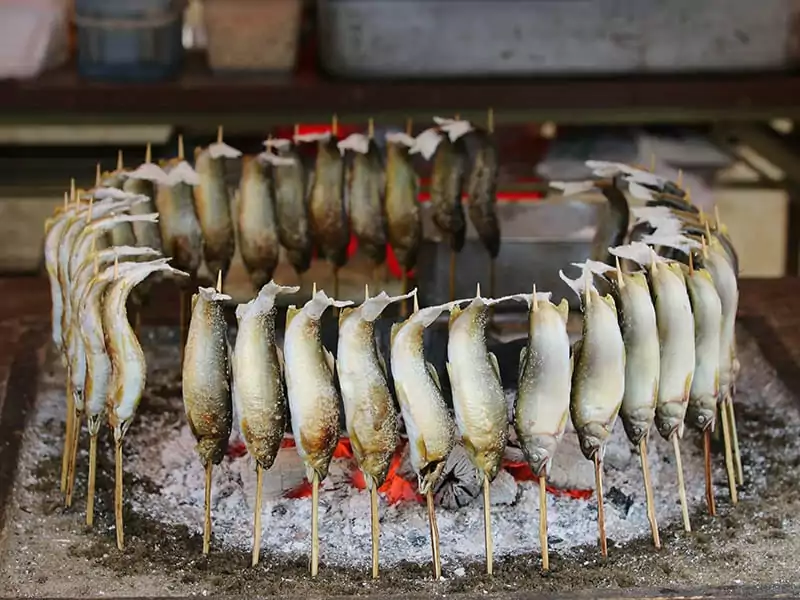
Do not look at the simple appearance of shioyaki and judge its quality. It is not just fish sticks, but it is the result of fish marinated with salt overnight and grilled with charcoal fire. This is a unique Japanese technique.
The fish has an incredible taste, and the meat is pretty tough, so you should prepare some Japanese beverages to drink while eating it. Nothing is better than enjoying a beer and this excellent grilled fish in the bustling streets.
Besides serving Shioyaki as a standalone dish, you can also enjoy it with sides such as rice, vegetables, or miso soup.
Quick fact: The term “shio” means salt, while “yaki” means grilled or broiled.
- 16. Mochi (Japanese Rice Cake)
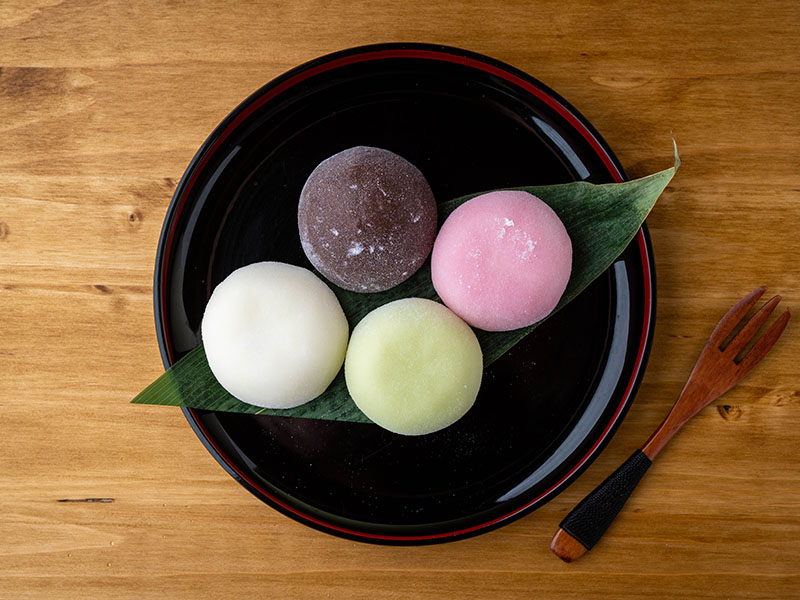
Mochi is a beloved traditional Japanese dish that is made from sticky rice. Creating these soft and supple mochi cakes requires a complex process of making the dough, filling, shaping the cake, and cooking it. While it may seem like a daunting task, making mochi today is much simpler than it used to be.
In the past, creating mochi was a time-consuming and labor-intensive process that involved pounding the rice with a pestle and mortar to create the necessary dough. However, with modern technology and equipment, the process has become much more streamlined.
Despite the evolution of the process, mochi remains an integral part of Japanese culture and is often enjoyed during special occasions such as New Year’s Eve, like Kagami mochi.
Mochi also comes in a variety of flavors, including matcha, strawberry, black sesame, and more.
Listen to the directions to make ice cream mochi.
- 17. Ikayaki (Grilled Squid With Soy Sauce)
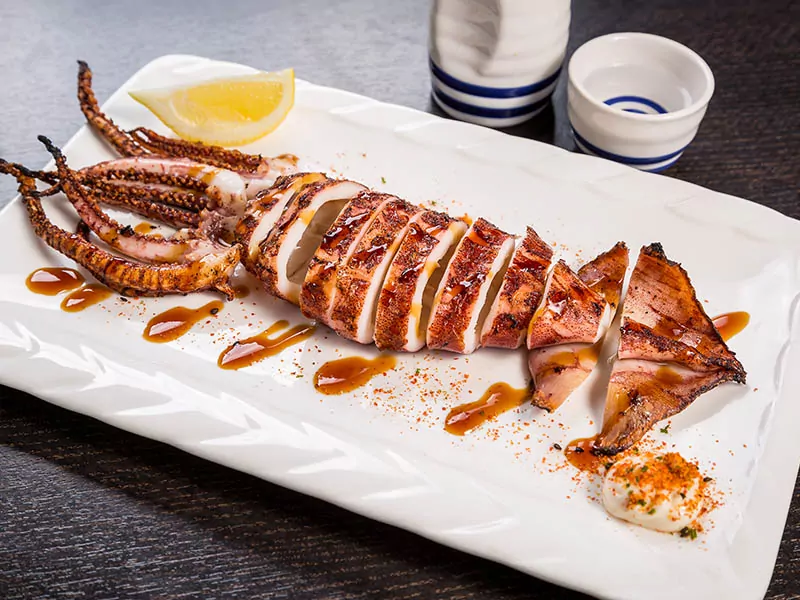
Ikayaki, a popular Japanese street food, features succulent grilled squid that is bathed in sweet soy sauce and cooked over charcoal.
This cooking technique results in a tender and smoky flavor that pairs well with the sweet and savory sauce.
They are normally served with the whole body pierced through a stick or ring cut from the body, depending on the size of the squid.
- 18. Takoyaki (Octopus Balls)
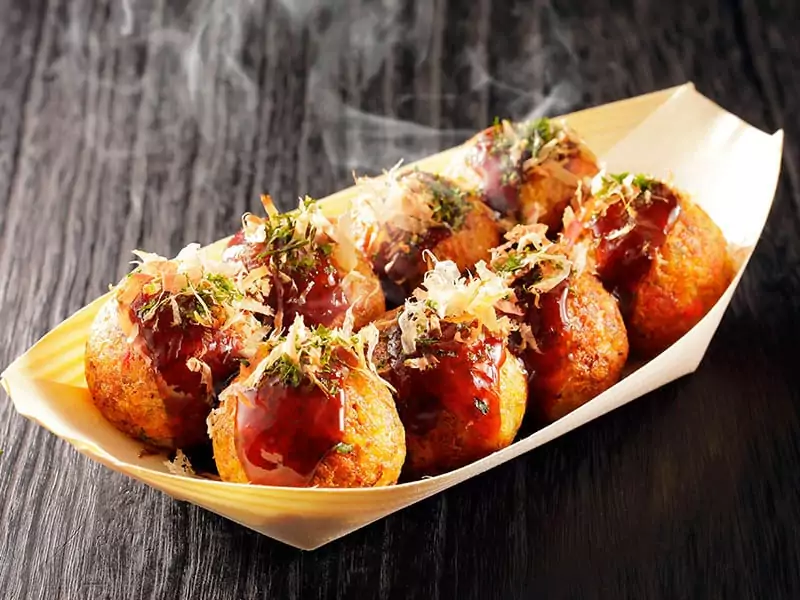
Speaking of famous Japanese street foods, it is impossible not to mention takoyaki, aka octopus ball. It is also a top favorite snack in Japan. These round balls are made with dough and an octopus in the middle.
The takoyaki is coated with takoyaki sauce for extra flavor. Furthermore, the greasy of the mayonnaise topping will leave an indelible impression in your mind.
Originally, this delicious Osaka-based street food was made by a vendor in 1935. Akashi city akashiyaki dumplings are considered to be the forerunners of this food.
It is time to explore all information about the history of takoyaki.
- 19. Okonomiyaki (Pan-Fried Cake With Seafood, Meat, And Vegetables)
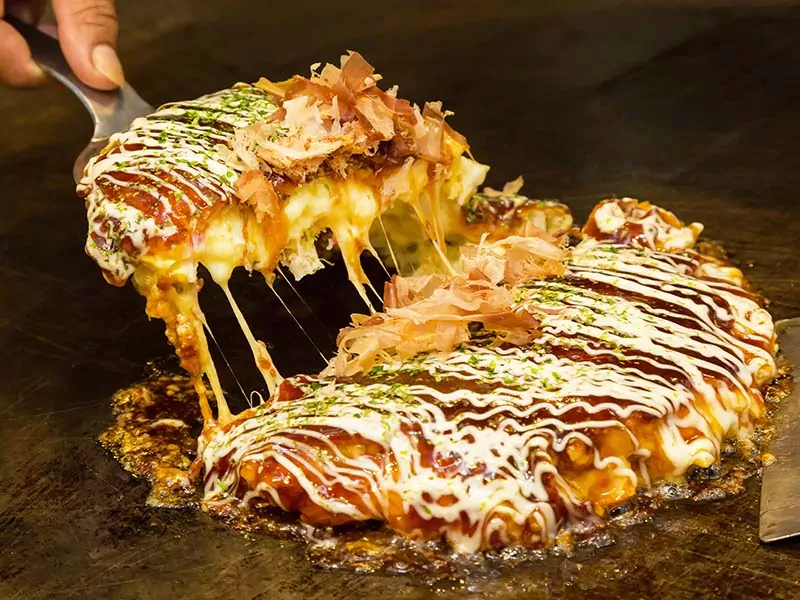
Okonomiyaki was first created in Osaka and Hiroshima and gradually spread throughout Japan. The flours are mixed with the cabbage and savory components to make a wonderful recipe that you should try.
This pancake will be pan-fried and covered with mayonnaise sauce. When you come to Japan, you will have the opportunity to make your okonomiyaki pancakes to enjoy on the spot. It is a perfect experience, isn’t it?
It is straightforward to make incredible okonomiyaki to enjoy at home.
- 20. Imagawayaki (Japanese Donuts)
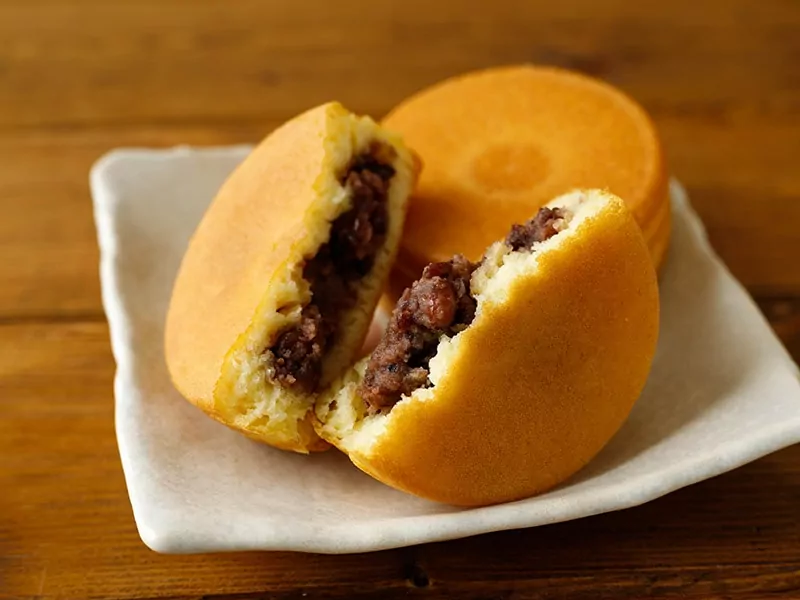
If you are a fan of the anime Doraemon, you will know this famous imagawayaki donut. This delicious treat is popular on the streets of Tokyo and throughout Japan. Therefore, let’s find them to taste right now.
Its name is inspired by the Imagawa Bridge. This is where these donuts were first sold in the late 1700s. Before that, it was called Obanyaki because it was shaped like the ancient Oban coin.
The outer layer of the cake is made from eggs and flour for excellent porosity. Depending on your preference, you can buy imagawayaki with fillings made from bean paste, custard, or chocolate.
If you don’t have a premium-quality donut maker at home and don’t want to figure out the best way to prep donuts with no donut pans , Imagawayaki will be the best choice for you. Why bother coming up with ways to create donut holes when you can just make donuts without ones?
- 21. Yakiimo (Roasted Sweet Potatoes)
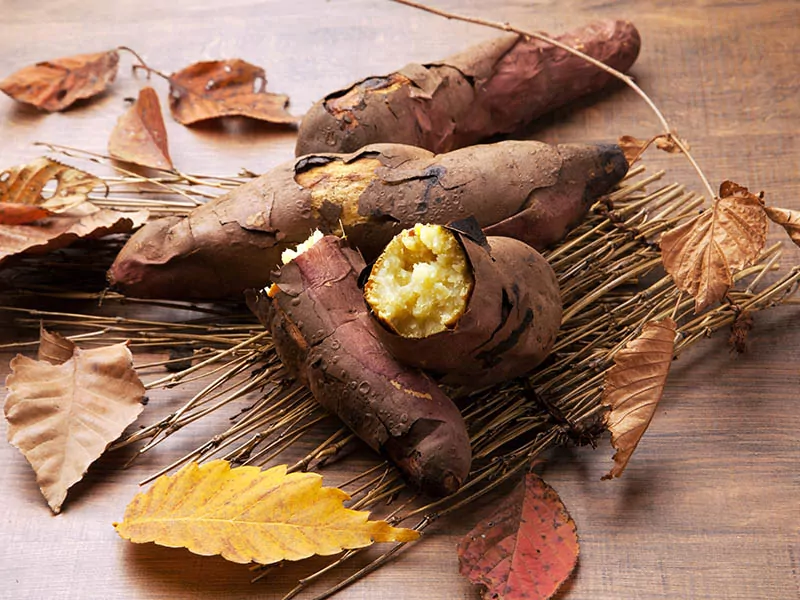
Yakiimo (aka roasted sweet potato) is another ideal street food not only in Japan but also in other East Asian countries.
When it was introduced to Japan in the 15th century, the Japanese created delicious yakiimo dishes for winter days to keep them warm.
A sweet potato called satsuma-imo is the main ingredient of this food. Sweet potatoes grilled over charcoal will have tough skin and soft, fluffy, and fragrant flesh. You can think of a caramel taste when you eat it.
Next to its wonderful flavor, this food also contains a large amount of protein, fat, vitamins, and minerals, making them a wholesome treat for everyone.
Other Incredible Japan’s Delicacies
The richness of Japanese cuisine offers many different wonderful options for you to enjoy. You can refer to the suggestions below to add to your food menu for this trip.
- 22. Tamagoyaki (Grilled Egg)
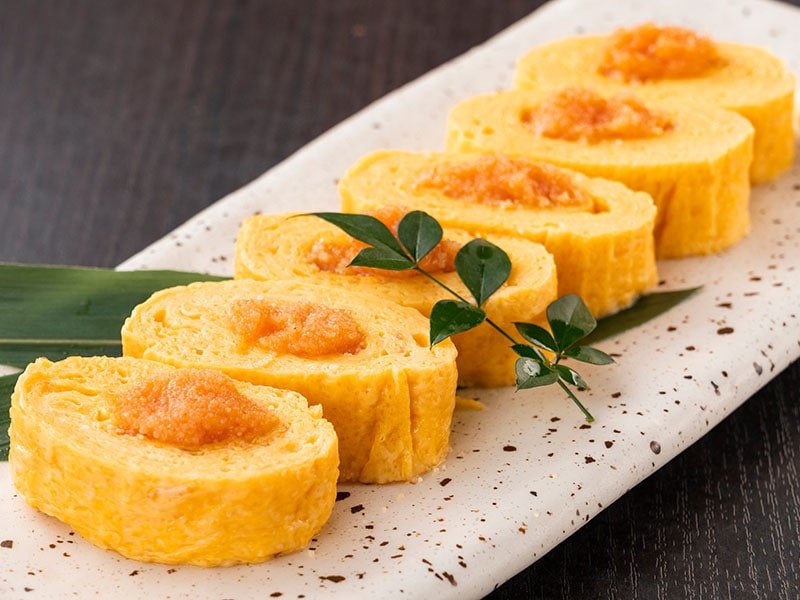
Tamagoyaki is a delicious addition to your Japanese breakfast recipes. The egg slices with their soft and spongy texture will melt in your mouth in no time. You will feel the gentle sweetness when enjoying this unique egg dish.
Thinly fried eggs are rolled into multiple layers and then cut into delicate slices, arranged beautifully to create an irresistible temptation. Overall, it is a popular feature at sushi parties and a must-try for any egg lover.
Quick fact: During the 1950s, tamagoyaki enjoyed its heyday, as eggs were encouraged by the government as a way for parents to provide their children with more protein.
Do not ignore these instructions to get the delicious tamagoyaki.
- 23. Natto (Steamed And Fermented Soybeans)
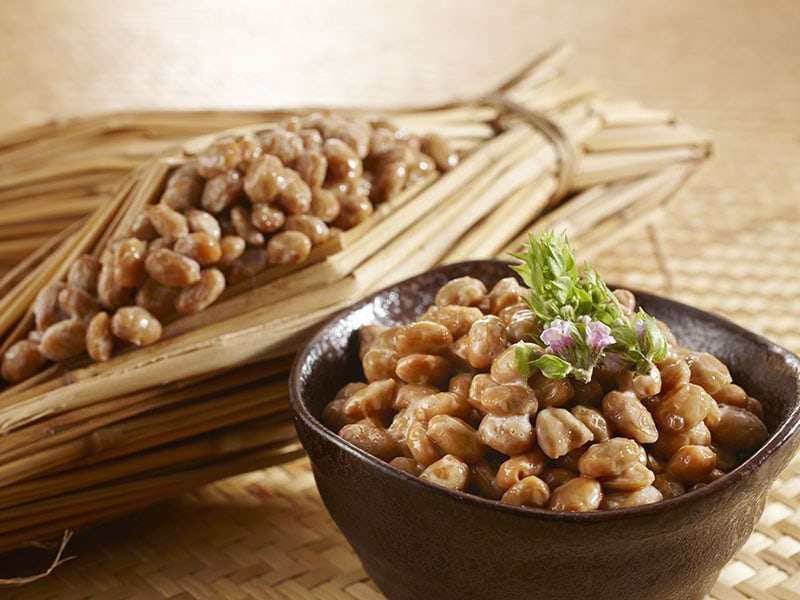
A traditional food I would recommend to you is natto. The soybeans are fermented with bacteria found in the human gastrointestinal tract. The flavor of these soybeans is pretty intense and will leave an unforgettable impression on you.
When you eat these beans, you will think of moldy cheese because of its smell. Some people will not like the scent, but its flavor will entice you. With their characteristic salty and umami taste, the beans will stimulate your taste buds.
You will get more nutrients after eating this food beginning with “N” . The high content of vitamin K2 and protein will be valuable for your health. Plus, this food is known to reduce blood pressure and blood glucose .
- 24. Sukiyaki (Japanese Hot Pot)
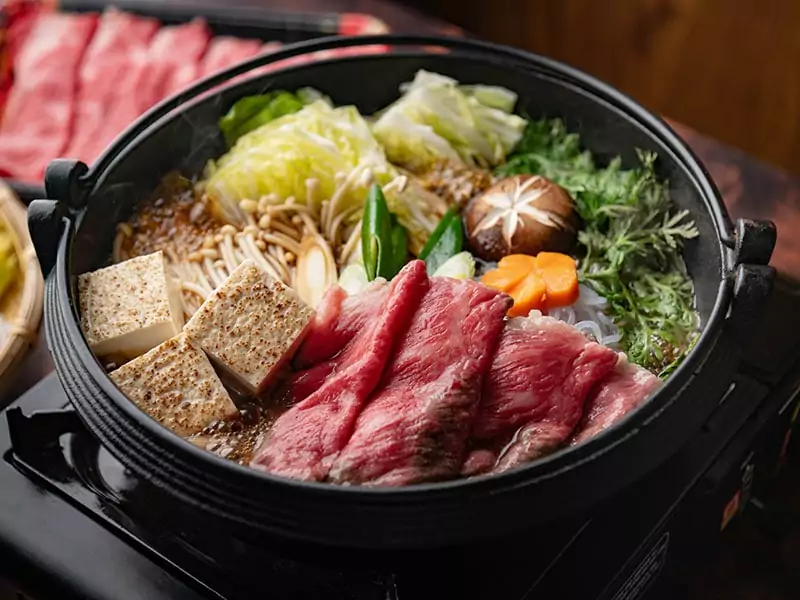
Sukiyaki translates to “cook what you like”, so this hot pot can hold any ingredients you want to add.
This traditional Japanese hot pot regularly includes thinly sliced beef, vegetables, and noodles, all cooked together in a savory broth made from soy sauce, sugar, and mirin.
Hot pot broth is the highlight of this remarkable dish. As you cook the ingredients together, the flavors meld and intensify, creating a rich and satisfying dish.
And while sukiyaki is often enjoyed in the winter months, there’s really no bad time to indulge in this delicious meal. In reality, this is a favorite choice of office workers at weekend parties.
Get the ways to have fantastic sukiyaki at home.
- 25. Oden (Japanese Fish Cake Stew)
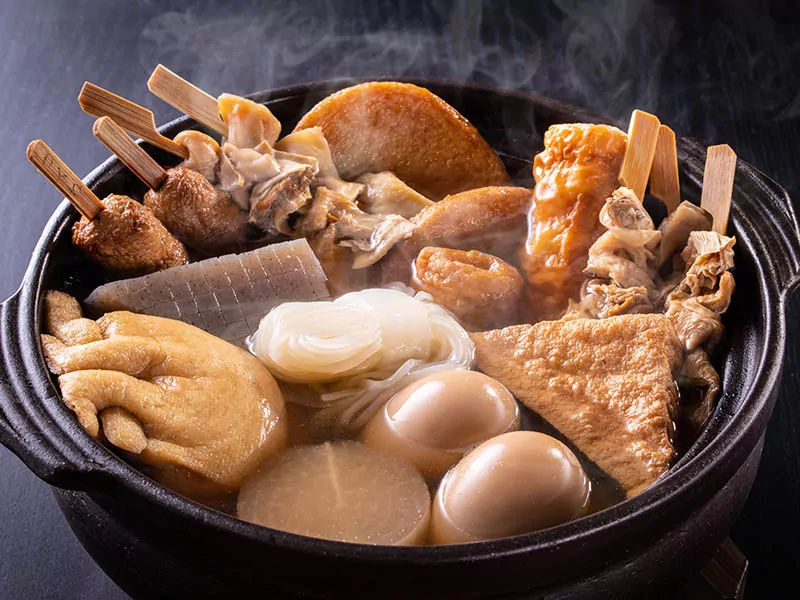
Warm up your cold winter nights with a delicious bowl of oden, a savory hot pot filled with an assortment of vegetables and ingredients.
Did you know that oden originated in the 14th century during the Muromachi era, with its earliest version being grilled tofu skewers coated in miso sauce?
Today, they mainly contain chewy mochi rice cakes, flavorful fish cakes, daikon radish, and eggs. And every bite is a symphony of flavor that will leave you wanting more.
The nourishing broth, made from bonito fish flakes and seaweed, will warm your body from the inside out. For a heartier meal, add in some noodles and sip a glass of wine with friends while relishing this dish.
- 26. Kare Raisu (Curry Rice)
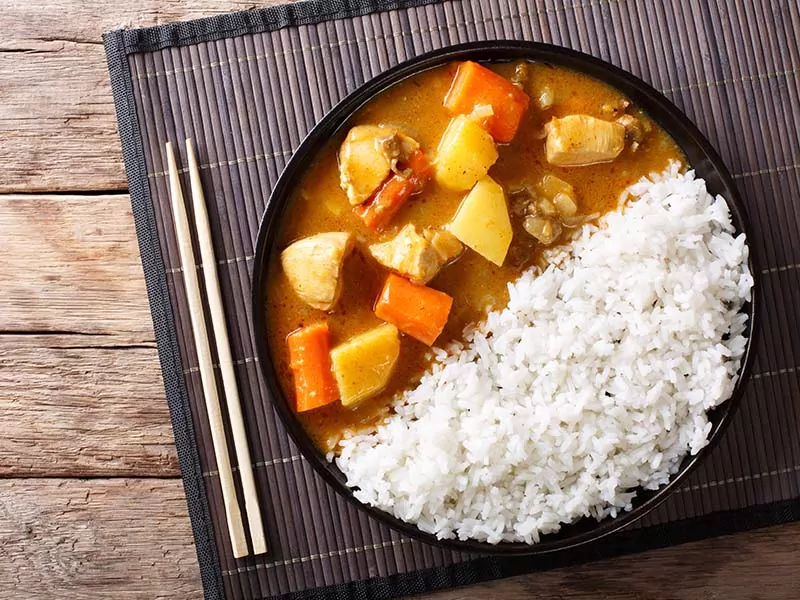
If you are looking for a rice dish to fill your hungry stomach, curry rice is suitable. It was brought to Japan by the British in the Meiji era, so it is pretty similar to United Kingdom curry.
Sweetness is the signature flavor of this beautiful dish. Curry is stewed for a long time with meat and vegetables. The soft and flexible rice grains will evenly absorb the curry juice, bringing an irresistible flavor to diners.
- 27. Miso Soup
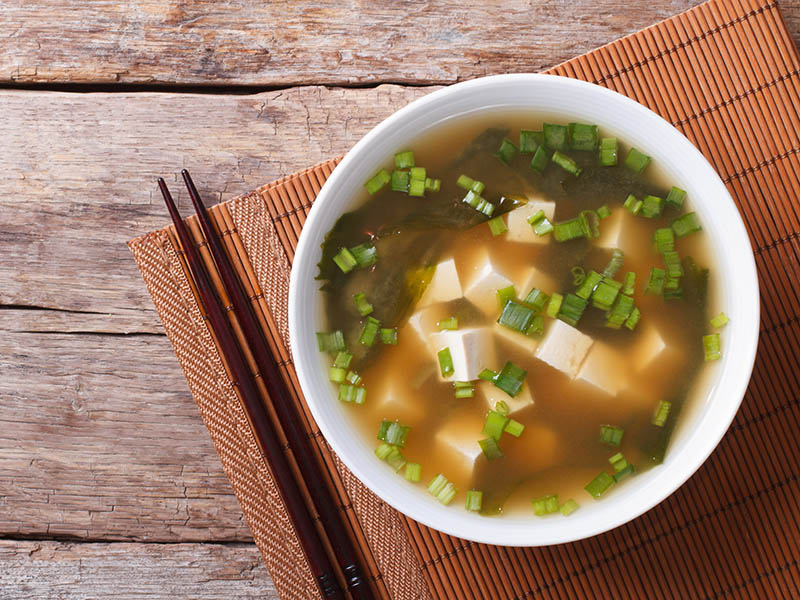
Miso soup is a culinary staple of Japanese cuisine. A small bowl of miso soup is always present in every Japanese meal and a common companion food for sushi . In fact, this is one of the most common side dishes of any Japanese delicacy.
Miso paste is fermented from soybeans, giving this recipe its distinctive flavor. Furthermore, you will enjoy the taste of dashi broth in this food. You will feel warm after sipping a cup of miso soup.
Miso is inspired by the fermented food of ancient China. It was brought to Japan and Korea in the 7th century.
Avoid 5 mistakes for a delicious miso soup.
- 28. Onigiri (Japanese Rice Balls)
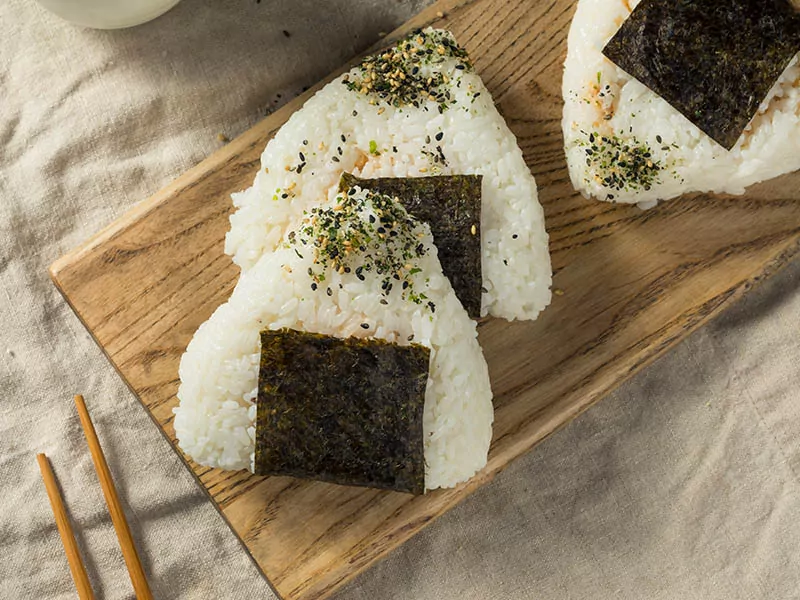
You are probably no stranger to Onigiri. It is considered a portable dish of the Japanese. You just need to go to convenience stores and wait for a few minutes to have an onigiri for breakfast.
It is also known by various names, such as “nigirimeshi”, “omusubi”, or “rice balls”. The triangular or cylindrical rice balls wrapped in dried seaweed (nori) with tuna or teriyaki chicken fillings are a great choice when there is not much time.
- 29. Omurice (Japanese Omelette Rice)
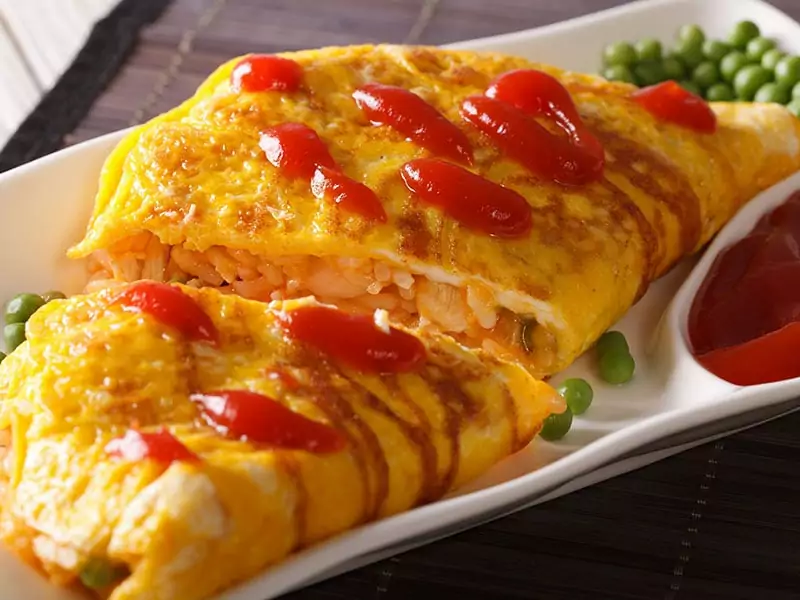
Omurice is believed to have originated in Japan in the early 1900s when Western cuisine was first introduced to Japan. So this delight is a perfect blend of Japanese and Western cuisine, particularly Japanese fried rice and Western-style omelette.
The name “omurice” is a combination of the words “omelette” and “rice” in English. It is also sometimes referred to as “omuraisu” in Japanese, which is a combination of the Japanese words for “omelette” and “rice”.
Omurice is a favorite dish among people of all ages in Japan, especially children. It is also popular in other parts of Asia and around the world, where it is served in Japanese restaurants.
If you prefer a home-cook recipe, the basic ingredients for Omurice include rice, eggs, and ketchup. The rice is usually fried with meat (typically chicken), vegetables, and ketchup. Then they will be wrapped in a thin omelette made of eggs.
There are many variations of omurice, with different fillings and sauces. Some popular varieties include curry omurice, seafood omurice, omurice with cheese, etc. In some versions, people can also replace fried rice with fried noodles.
- 30. Unagi No Kabayaki (Grilled Eel)
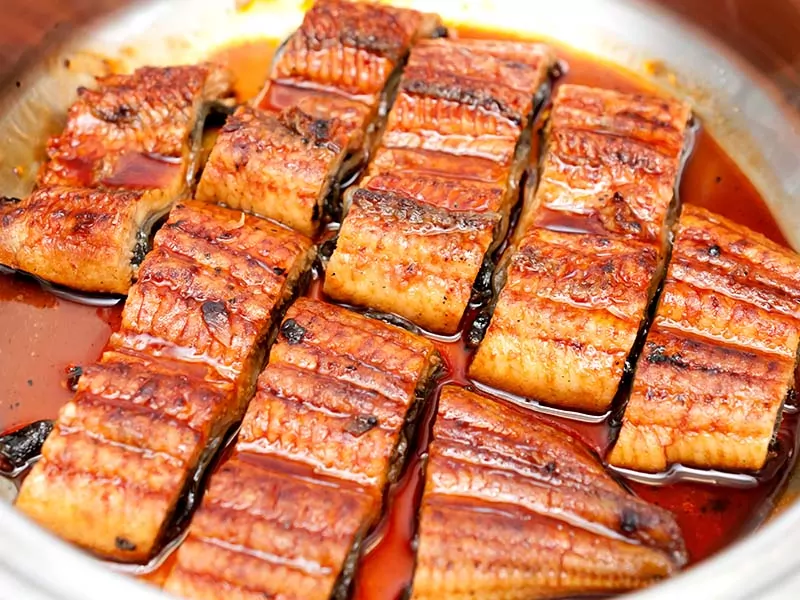
If you travel to Japan during the summer, you will have the opportunity to enjoy unagi no kabayaki with the best and definitive flavor. This unique dish has been around since the Edo period.
Pieces of eel are grilled on a griddle with kabayaki sauce. This is a sweet sauce with soy sauce as the primary ingredient. The Japanese also replace eel with fish in the seasons when there are few eels.
Grilled eel is a popular component in sushi. On the other hand, locals also serve it over a bed of rice (aka Donburi – a rice-bowl dish with meat, vegetables, or meat). With eel, it is called Unagi Donburi.
- 31. Gyoza (Japanese Potstickers)
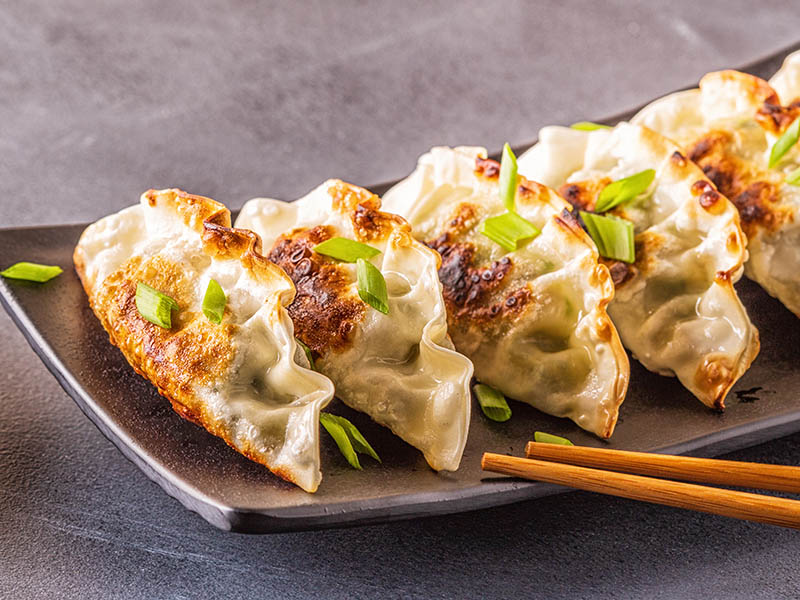
These half-moon-shaped dumplings will leave you spellbound. The rich filling combines minced pork, mushrooms, cabbage, and other elements. In addition, you will enjoy many different versions of the filling depending on the restaurant you choose.
For example, chefs might swap out pork for beef, hence resulting in a mouth-watering Japanese ground beef dish. Other unconventional fillings might also include lamb, seafood, or cheese.
Until now, you may think gyoza is quite similar to regular dumplings. But the outer layer is what sets these potstickers apart from other dumplings . The chef will fry them on one side and steam them for about 2 to 3 minutes to bring out gyozas with a succulent filling and silky wrapping.
China was considered the homeland of this food when Jiaozi was invented. Japanese soldiers stationed in China during World War II brought this recipe back to Japan when they returned.
You will regret it if you do not taste yummy gyoza.
- 32. Gyudon (Beef And Rice)
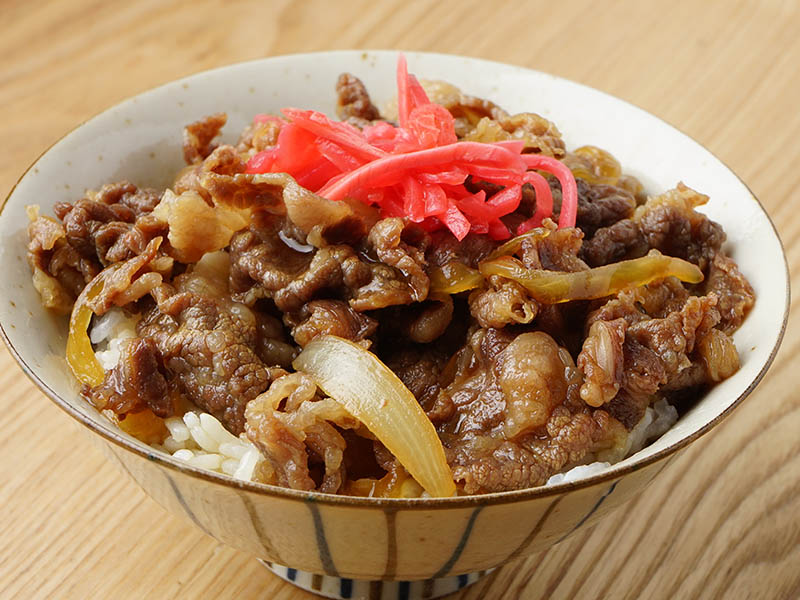
Gyudon was very common in the Meiji era from 1868 to 1912. It combines rice and beef with a rich taste as Gyudon is seasoned with various spices. If you want to enjoy this feast at its best, you should go to Sukiya – the biggest Gyudon restaurant chain.
A small salad and a bowl of hot miso soup are typical side dishes of Gyudon. There is no need to worry about its price because it is pretty cheap and still ensures a full stomach for you after eating it.
For more information, Japan’s lunchtime favorites include a variety of rice bowls and noodle dishes such as Gyudon beef bowls, ramen, soba, and udon. It’s common for individuals to pack bento lunch boxes for school or work.
- 33. Edamame (Boiled Green Soybeans)
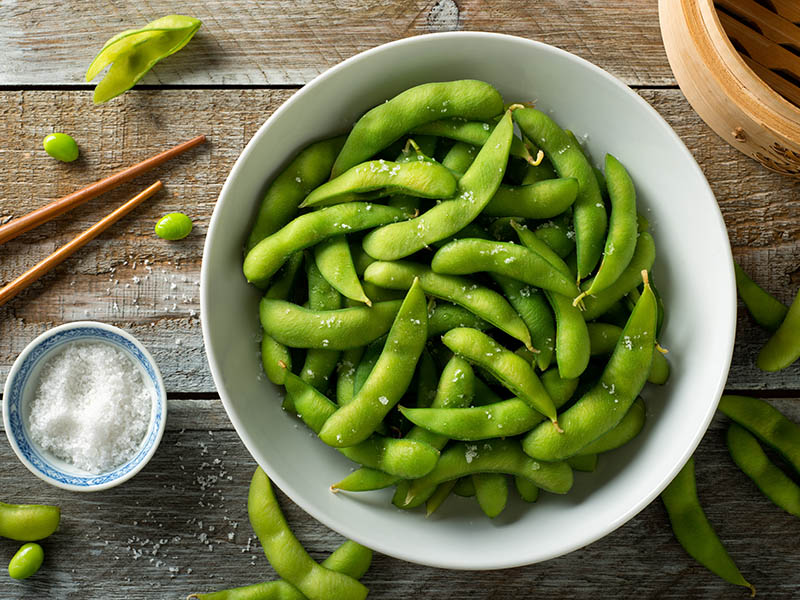
In Japan, edamame is a popular snack that you can easily find in pubs and restaurants. In general, edamame is soybeans harvested when they are still young.
They are lightly blanched in boiling water to preserve their natural sweetness and crunchiness. Unlike mature soybeans, edamame is consumed while they are still in the pods, which adds a fun and interactive element to the snacking experience.
In addition to being a delicious snack, this food is also a healthy one, as it is a good source of protein, calcium, and iron .
Despite its popularity in Japan, edamame actually has its roots in China, where it is believed to have first appeared around 200 BC.
- 34. Kurisumasu Keki (Japanese Christmas Cake)
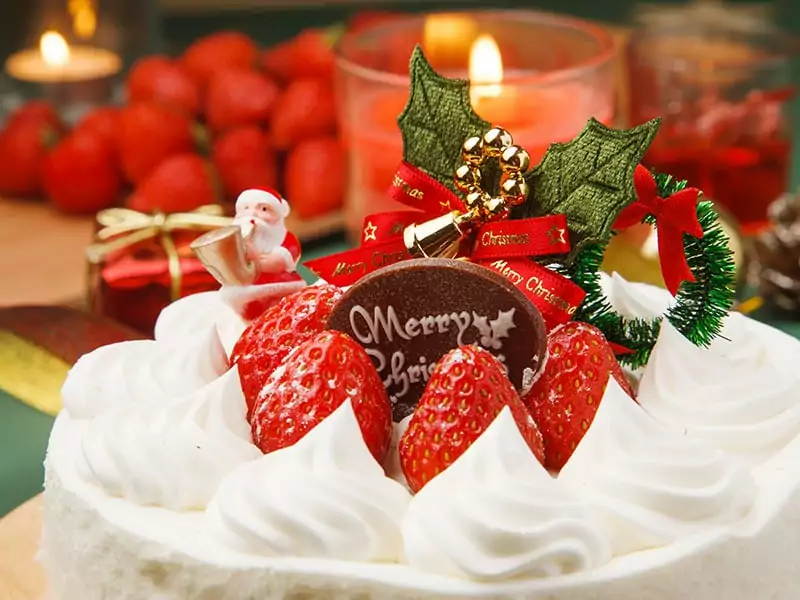
Kurisumasu Keki, or Japanese Christmas Cake, is a famous dessert in Japan during the holiday season. It is a light and fluffy sponge cake that is typically layered with whipped cream and decorated with strawberries.
The history of the Japanese Christmas Cake can be traced back to the Meiji period when Western-style desserts became more popular in Japan. Today, the Christmas cake is an important part of Japanese Christmas celebrations.
The flavor of Kurisumasu Keki is generally light and not too sweet. Additionally, the fresh strawberries add a juicy, slightly tart flavor that provides a nice contrast to the soft sweetness of the cake and cream.
Overall, it is a perfect dessert for celebrating Christmas with friends and family in Japan.
- 35. Kaiseki (Multi-Course Japanese Meal)
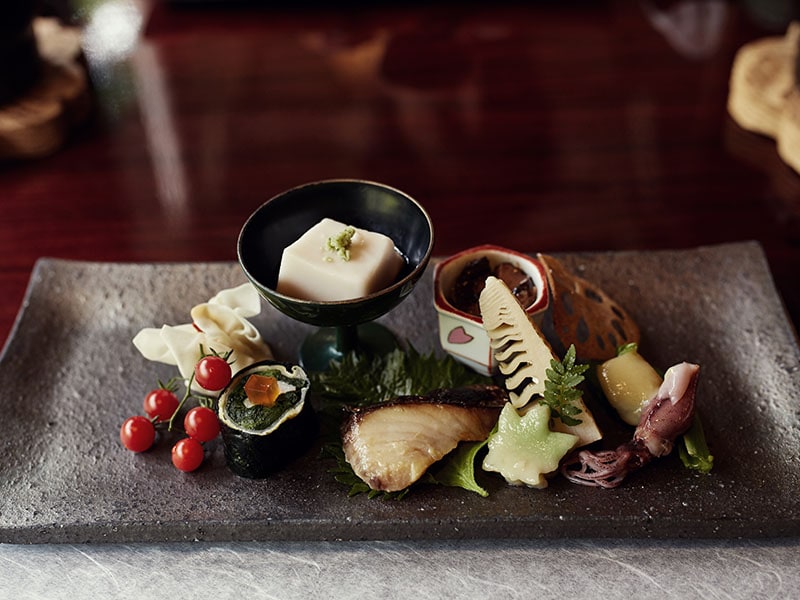
The last one is Kaiseki, which is not the name of a Japan’s dish. In fact, it is a culinary term referring to traditional Japanese multi-course that emphasizes the harmony of taste, texture, and presentation.
The meal typically includes a series of small, carefully prepared dishes that showcase the high-quality seasonal ingredients and flavors of Japan. Kaiseki often involves elaborate presentations and is served in a tranquil setting. That’s why it is similar to Western haute cuisine.
Kaiseki is considered a form of art, and it reflects the culture, aesthetics, and philosophy of Japan. The meal may be paired with sake or other Japanese beverages. And it is often served at high-end restaurants and ryokans (traditional Japanese inns).
Thus, Kaiseki might be a bit expensive, but it is worth it to try and improve your culinary journey while visiting Japan.
Finally, here are some frequently asked questions and answers to help you expand your knowledge about this brilliant culinary practice.
Sushi, ramen, miso soup, Yakitori, Tempura are some common names when it comes to Japanese food.
A typical Japanese lunch usually consists of a main dish, such as rice or noodles, accompanied by side dishes, such as miso soup, pickles, and vegetables.
Moreover, bento boxes are also a popular lunch option. A bento typically consists of rice, meat or fish, vegetables, and other small items such as tamagoyaki (sweet omelet) and fruit, all arranged in a box-shaped container.
Rice is the staple food in Japan and is consumed at almost every meal. In addition to rice, other common foods that Japanese people eat a lot are seafood (fish is the most eaten one), vegetables, and noodles.
Sushi always contains vinegared rice, which adds flavor and texture, while sashimi is simply raw fish or seafood, without rice.
Sushi is typically served with soy sauce, wasabi, and pickled ginger, while sashimi is often accompanied by a small dish of soy sauce and wasabi for dipping.
Mochi, Dango, and matcha desserts are some iconic Japan’s sweet courses that you will love.
For example, a basic bowl of ramen at a casual noodle shop might cost around 500-800 yen (about $4.50-$7.50 USD), while a higher-end bowl at a specialty ramen restaurant could cost 1,000-1,500 yen (about $9-$14 USD) or more.
Similarly, sushi can range from affordable conveyor belt sushi restaurants, where plates typically cost 100-500 yen (about $1-$5 USD), to high-end sushi restaurants where a single piece of sushi could cost 1,000 yen (about $9 USD) or more.
- Feast Your Eyes and Palate: Japanese Cuisine at Its Finest
Have you tried any of the foods on this list? I hope this article will help you better understand Japanese cuisine and make it easier to choose delicious dishes to enjoy when you come to Japan.
As always, I’m eager to hear your thoughts and suggestions on how we can improve our content and provide you with an exceptional experience. So, feel free to drop your comments below, and let’s discuss more Japanese cuisine. Thanks for taking the time to read this article, I appreciate it!
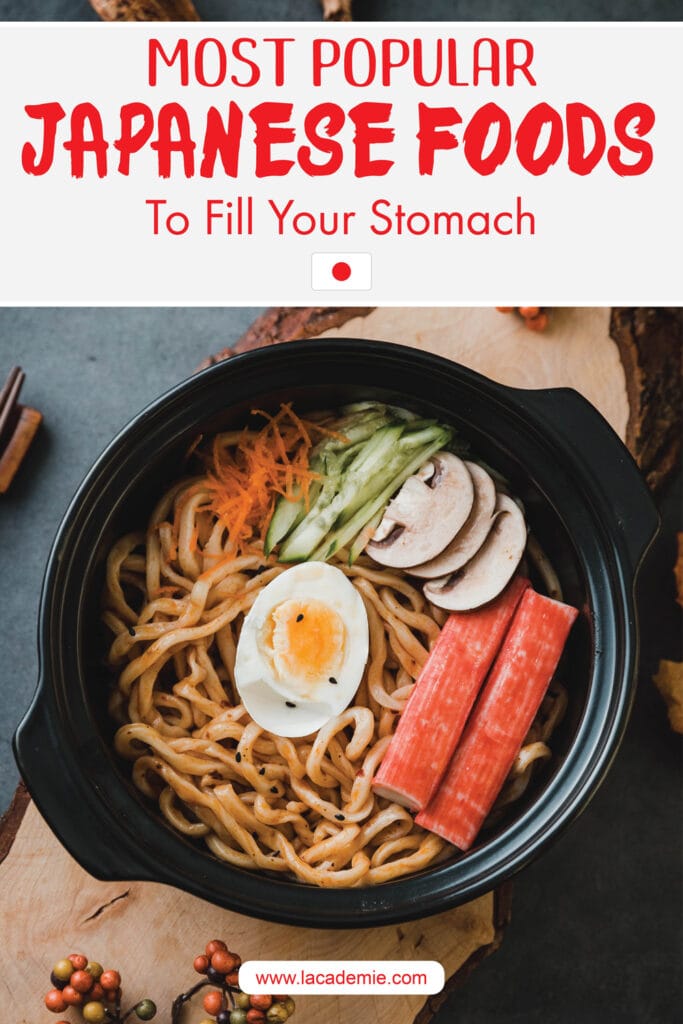
Table of Contents

Jamie Scott is a food enthusiast and talented cook with over 15 years of experience in the culinary industry. Holding a degree in Nutrition, Jamie specializes in creating nutritious and delicious meals. As the Lead Author and Content Creator for Lacademie.com, Jamie shares his passion for food, nutrition, and cooking, providing readers with engaging content and inspiring recipes.
Member Login

Moritsuke: The Japanese Art of Presenting Food
By Christine Dzujna

The Japanese art of presenting food, moritsuke , was the subject of Elizabeth Andoh’s lavishly-illustrated presentation at the serene Globus washitsu. American-born Andoh has made Japan her home for more than 50 years and is a leading authority on Japanese culinary culture. She approached moritsuke by identifying three elements that govern the aesthetics of the traditional Japanese meal: (1) the choice of foods to serve, (2) the dinnerware in which the food is served, and (3) the exacting placement of each piece of dinnerware in front of the diner.

Each plate is chosen for its ability to make the food more attractive and easier to eat. A long narrow platter pleasingly accentuates a plank of fish, and rounded bowls or curved plates can best highlight and soften linear items such as strips of vegetables and skewers of food. Diminutive bowls of condiments and side dishes are arrayed around the main meal components.
As in the U.S., the seasons inspire certain foods and dishes in Japan. Fall, they say, is the most delicious time of the year when the most desirable ingredients – mushrooms and daikon radish – are at their prime. Pine, bamboo, plum (the three friends of winter) are popular motifs that help create a sense of time and place and food is often carved or arranged in their likeness, especially in platters prepared for New Year’s celebrations. Carrots, too, are regularly fashioned into seasonal motifs such as the maple leaf in fall and the cherry blossom in spring.
Meals on the go call for the use of the obento box, a handy food organizer that allows for easy extraction without messiness. The carrier need not be elegant and is often made of plastic, though a wooden receptacle is best for unrefrigerated food since it can absorb moisture that leads to spoilage. An obento accomplishes a straightforward and simple task but can also carry a great deal of meaning. Andoh described them as canvasses on which a painting is made and they are often turned into message boards through which the food preparer communicates with the person being fed (e.g. a wife who reminds her husband to pick up milk via his lunch obento ).
Andoh emphasized that moritsuke is both artistic and practical: serving rice and soup in small bowls ( kobachi ) allows the food to be comfortably held and brought closer to the mouth, thereby minimizing accidents that can occur when plates remain rooted to the table.
The manner in which food is arranged on a vessel, or utsuwa , is subject to certain aesthetic rules. Hira mori means “flat arrangement” and is often expressed as thin slices of nearly transparent fish placed on a patterned dish that allows the design of the dish to be visible through the fish. This practice helps to demonstrate the skill of the chef. Food can also be arrayed to achieve height in a sugi mori (“cedar arrangement”) composition that resembles a tree standing tall. Tawara mori refers to a bale of harvested rice, and yose mori is a gathered arrangement that, if properly set up, will allow a diner to remove pieces of the whole without causing an entire collapse.

Such thoughtfulness in plating means that dinnerware purchases are made with careful consideration. Andoh spends hours looking for the right pieces and will hold each item to assess its weight and comfort, its textural nuances and shape. Composition is important because a soup bowl must suitably hold hot liquids, and the rim should promote optimal enjoyment of the contents; metal will feel very differently in the mouth than wood. Wood bowls and utensils are gentler to the touch and allow food’s flavor to shine. Other oft-used materials include bamboo and clay of which there are hundreds of types, some more volcanic than others. Lacquerware is dry and durable and has a good mouth feel, but it’s made from tree sap that can irritate the hands. A vessel’s makeup dictates how food is prepared and both its flavor and display may be altered by the selection.
Andoh reminded us that certain dining customs have become so habituated that they require no thought to execute. For example, chopsticks are always placed to the left, whether the diner is right or left- handed and are set down on a horizontal angle with the mouth tips pointed toward the rice bowl, an invitation to the diner to pick them up and begin eating. Notably, once the chopsticks are taken up, they are first dipped in the miso soup to help prevent the rice from sticking.
The bowl of rice is always placed at the bottom left for easy access and because this positioning is seen as a sign of respect for the rice grower. The soup bowl is generally placed to the right of the rice and items harder to eat may be set in the lower right corner of the tray so that they have less distance to travel from plate to diner. The reverence and thoughtfulness engendered by these routines allows one to pause and consider the meal about to be consumed and to feel gratitude towards those who made it possible. Habits like these, says Andoh, develop into experiential knowledge that, unfortunately, is declining in Japan and the young today are not as conversant in these customs.

The bites we appreciated very much after the presentation were largely prepared by Andoh and consisted of trays of sliced carrots, cucumbers, and daikon accompanied by dips she brought from Japan, including a tart miso-mustard, known as karashi su miso , and a pungent kinzanji miso , made with rice, soybean and mashed with eggplant, ginger and other vegetables that ferments for up to 8 weeks. The kinzanji miso history dates back almost 800 years, and it is believed that monks first popularized the method of using vegetable scraps to make the condiment. Wasabi crackers that woke up the palate were also served as were a variety of sweet confections from Sunrise Mart, the Japanese grocery store on East 9th Street. Light and refreshing sake rounded out the offerings.

Join our Convivial Community
Pull up a member’s chair to enjoy all the benefits of our intellectual feast by becoming a member today; your support is vital and helps us fulfill our mission.
Not yet ready to commit? Join our mailing list to receive advance notice of upcoming events and opportunities to purchase tickets.

- Gift Certificate
- Testimonials

Make a reservation
To make your reservation online, please select a restaurant from the list below
- The Rocks Teppanyaki
Order Online

Kobe Jones Blog
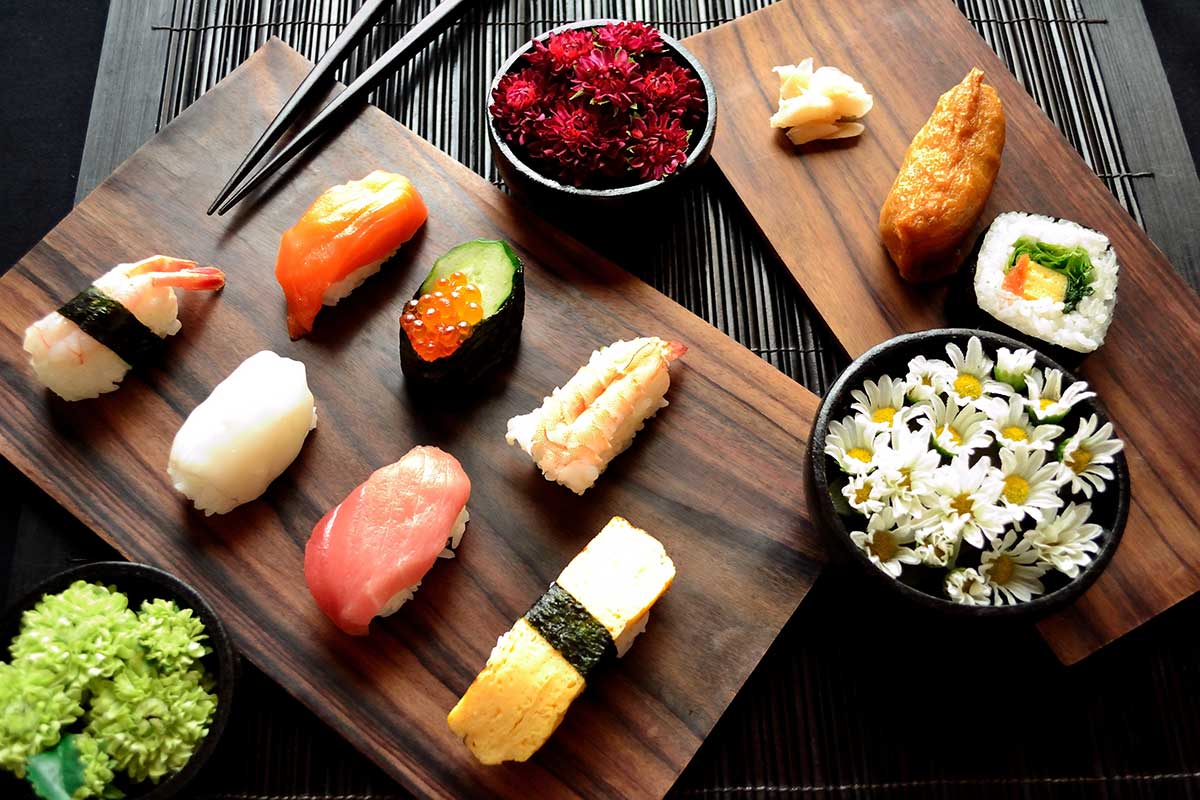
The Art of Japanese Food Decoration
If you’ve ever eaten Japanese food, you’ll know that visual presentation is an absolutely essential ingredient – it’s as much a part of the dining experience as the actual taste of the food.
When Japanese chefs prepare their food, every aspect from the arrangement on the plate, through to the garnish on top, is carefully chosen.
How do they do it?
The presentation of Japanese cuisine follows key plating principles and concepts. It’s all about minimalism, beauty and uniqueness.
You’ll never see a Japanese dish overloaded with food and you’ll always find a mix of interesting colours, patterns and texture.
Here are the basic rules of Japanese food presentation followed in the kitchen of your favorite Japanese restaurants:
1. Asymmetry and balance
While Western foods are presented on round plates and food is plated with symmetry in mind, Japanese food is served on plates and bowls of varying shapes and sizes.
The art of the dishes makes use of the food’s height and contrast, with components placed slightly askew to create drama on the plate. The more variety in colour, texture, arrangement and size, the better. Asymmetry can also be reflected in the quantity of food – you’ll often see Japanese servings in threes, fives and sevens. Five is the most common, as it represents the five tastes: sweet, savory, salty, sour and bitter.
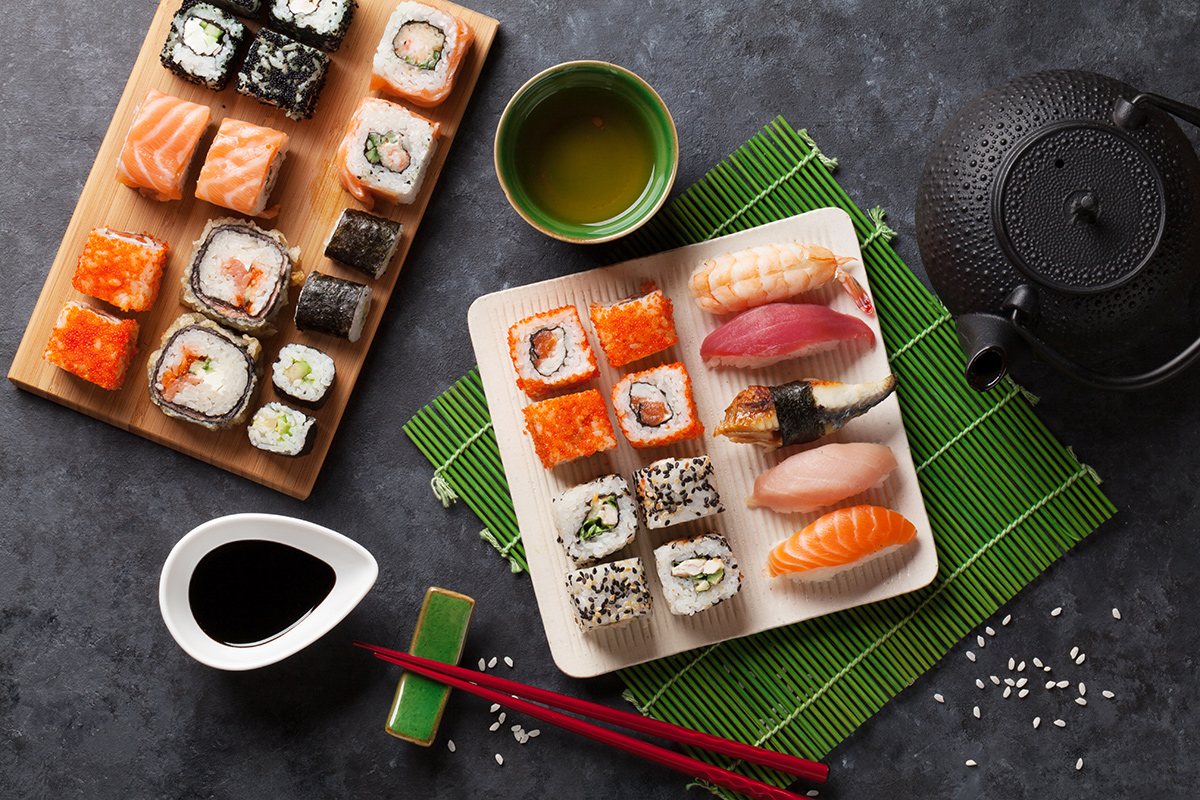
There are five key colours used in Japanese cooking – red, green, black, white and yellow – and you’ll find all five colours present in each arrangement. This combination of colours is important to Japanese cooking as not only is it pleasing to the eye, it also ensures that the dish is balanced and healthy with different vitamins and minerals contained within its ingredients.
3. Empty space
You’ll very rarely see a Japanese plate full to the edges. Where in Western culture there is sometimes a mentality of ‘the more food on the plate, the better’, Japanese plates will generally be at least 30% empty – known as ‘ma’. The minimalistic style of ma is also emanated in Japanese interior design and artwork, with the idea that negative space focuses the viewer’s attention on what they should be looking at.
4. Seasonality
In Japan, the four seasons are clearly defined and this is reflected in both the cuisine eaten and the presentation of the food. In autumn, red and gold leaves can be used to decorate the plate while in spring, sashimi can be served on dishes in a way that forms a little landscape, to reflect the blossoming of new life. Whites are commonly used in winter to mirror the falling of snow, pinks in spring for the cherry blossom, and reds as well as greens in summer. These colours are not only seen in the food but also on the chopsticks, plates and bowls the food is served with.
5. Serving utensils
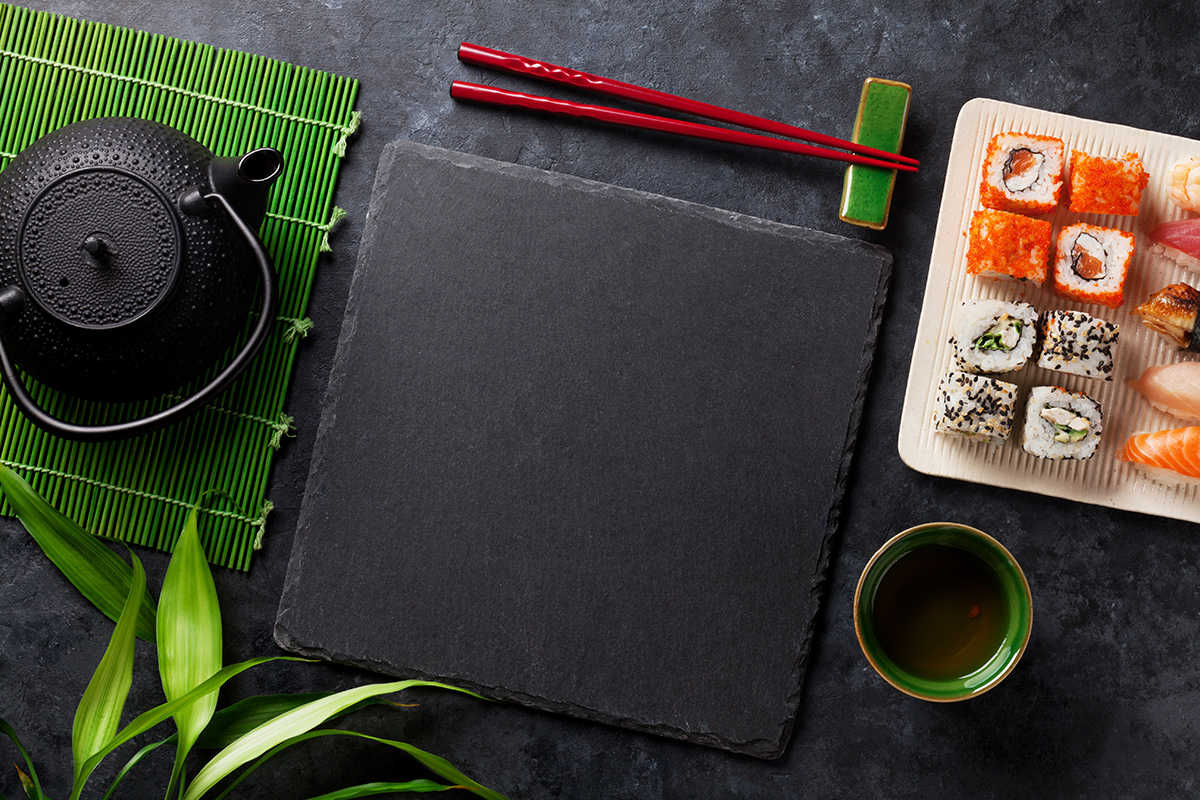
Japanese vessels come in a wide variety of colours, sizes and shapes. It is not uncommon for them to be decorated with eye catching patterns and made from different materials like lacquer, glass and pottery. The receptacle used will be chosen based on what dish it will be presenting and can even sometimes be the inspiration for the actual dish itself.
6. Garnish and decoration
The garnish of a dish comes last but is certainly not considered to be of ‘least’ value. The finishing touches on a Japanese meal enhance the intricate balance of colours and textures created by the contrast in foods and servingware. Certain garnishes will suit certain meals – for example, fish is traditionally served with lemon, but as more and more chefs begin to experiment we are seeing the use of flowers in garnishing. Whichever garnish is chosen, its aim is to balance out the dish and give the viewer a sense of overall peace and quiet.
What is food art?
Food art, or ‘mukimono’ is the art of carving vegetables, fruits and other foods into interesting shapes. Have you ever seen vegetables carved and shaped into flowers? In fact, the art of food carving is an ancient Japanese practice that has been around for thousands of years. The aim of mukimono is to bring excitement to a dish. If you’re feeling inspired to add a little wow to your own dishes, check out this amazing example of food art you can try in your own kitchen at home.
Master the art of food decoration
The Japanese have mastered the art of creating an artwork out of their meals and it keeps their customers coming back for more.
Have we got you craving some creative and delicious modern Japanese food? Head to your nearest Kobe Jones restaurant in Sydney or Melbourne .
Make a reservation or order online
Reservations, enquiries & payment, find out what’s on, latest events, takeaway, pickup & kerbside menus.
The Rocks Teppanyaki is now serving our famous traditional Japanese teppanyaki cuisine 7 days a week for lunch and…
Love being the first to hear about the latest events, offers and special promotions?
Sign-up to our newsletter now to keep up to date.
- State NSW VIC
- What’s On
- Book A Function
- Privacy Policy
- Terms Of Use
Copyright © 2017 – The Rocks Teppanyaki Pty Ltd. All rights reserved.

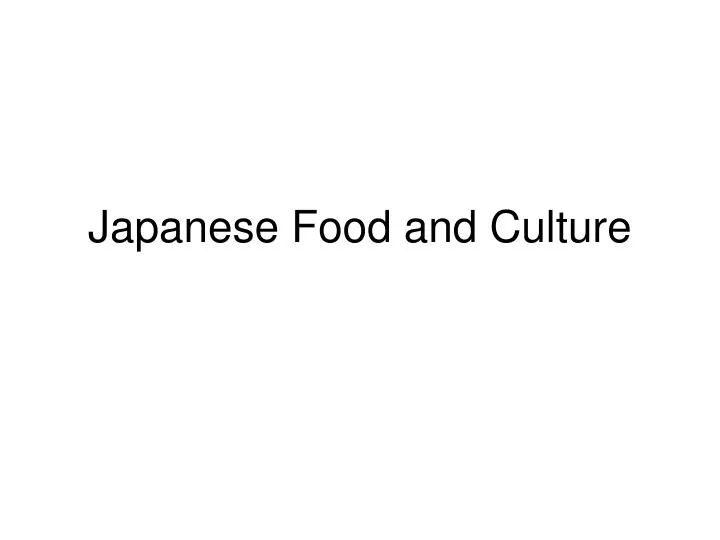
Japanese Food and Culture
Nov 09, 2012
1k likes | 3k Views
Japanese Food and Culture. The Island of Japan. The Meal ( gohan ). Two Kinds of Food: ‘Staple’ and ‘Other dishes’ Staple (gohan) is rice Other dishes (okazu) are fish, meat, vegetables. Traditional Concept of Meal . Neutral flavor of rice considered complement to meal
Share Presentation
- monosodium glutamate
- culture change
- western dining tables
- western furniture
- japanese table manners

Presentation Transcript
The Island of Japan
The Meal (gohan) • Two Kinds of Food: • ‘Staple’ and ‘Other dishes’ • Staple (gohan) is rice • Other dishes (okazu) are fish, meat, vegetables
Traditional Concept of Meal • Neutral flavor of rice considered complement to meal • Fill up on gohan, okazu stimulate appetite • Traditional meal has no Western counterpart • Sake = rice, so the two are not consumed simultaneously • Most basic meal: rice, soup, side dish
Courses of a typical Japanese meal today
Side dishes with rice and with sake
The Table • Zen • Traditional, personal table • Box with tray, individual sets of bowls, chopsticks, spoons • 20-30 cm per side 15-20 cm high • Cleaned 3x a month • Location from kitchen indicated status • Men > Women, Elderly > Junior
The Table • Chabudai • Low dining table • Adapted from Western dining tables • 30 cm high • More convenient than zen ●Fewer plates set ●Cleaner • Indicative of culture change
The Table • Table and Chairs • Today Western dining table and chairs are adopted • Began with farmers (to avoid mud on tatami floor) • Gradually spread in popularity • As Japanese economy grew and democracy expanded, expensive Western furniture was in vogue
Zen and Chabudai
Chopsticks and Manners • Japanese differ from Chinese • Made of lacquered wood • Women and children have smaller chopsticks
Chopstick etiquette • Breaches of etiquette: • Clutched, Piercing, Scooping, Cramming, Licked, Crying, Racking, Chewed, Dragging, Hesitating, Roving, Probing, etc. • No sharing of chopsticks! • Spiritual contamination • Chopstick rest
Etiquette-As You Like It • Traditionally: alternate rice and side dish • Acceptable to hold bowl of rice/soup to eat • Sake served warm However: Japanese table manners developed on the premise of eating from tiny individualized tables (zen), while using Japanese tableware for Japanese cuisine consisting mainly of rice. Today Japanese, Western, or Chinese-style utensils may be used, foreign foods are part of the cuisine, etc. Traditional etiquette has not made the transition
SOUP • Soup • Present at all meals (“one soup, one side dish, and rice” for the minimum complete meal) • Two kinds: • Sumashi-jiru—clear stock/salt broth • Miso-shiru—miso dissolved into thick solution Includes vegetables, meat, etc. to be eaten with chopsticks Broth is typically drunk from bowl, which is held in the left hand (chopsticks right)
Umami aka “Deliciousness” • Dashi—soup stock made chiefly from kelp but also dried bonito, dried sardines, and shitake mushrooms • Acts as a multiplier and enhances flavor of other foods • Called the 5th taste (not present in Western cuisine) • Prof Ikeda Kiknae of Tokyo University isolated umami and produced crystal form known as monosodium glutamate (MSG) in 1908
Sashimi—Cuisine not cooked • Japanese philosophy: “Food should be enjoyed as close as possible to natural state” • Sashimi—raw fish • Raw -> Grill -> Simmer, depending on freshness of fish • Prefer sea fish over freshwater because of the odor
Sushi—Fast Food • 19th century popular snack food • Men majority of sushi chefs • Dip fish side in sauce • Pickled ginger between pieces to “extinguish taste” • Nigari-zushi—rice with raw fish on top • Maki-zushi—seaweed rolls • Inari-zushi—bean curd pouch w/ rice
How to roll maki-zushi
Japanese Cuisine • Suyaki—beef • Fugu—puffer fish, delicacy • Tofu and Natto--soybeans • Tempura • Noodles • Pickles and Preserved Seafood • Daikon
Dessert? • Mochi—rice cakes • Sugar historically rare • Green tea taken after meals to “quench thirst and change the mood” • Sweets taken with tea between meals • Dessert stems from Western influence
Sake v. Green Tea • Sake wine and tea are opposites • Sweet-tooth type or drinking type • Ceramic cups, bowls, pots used for green tea • Cups with handles used for coffee • Milk and soda are served in glasses
Culture Change • Isolated for 2.5 centuries • This period is known as the Edo period • Allowed Japanese culture/cuisine to distinctly develop • 1958 Japan forced to trade with US, Britain, France, Netherlands, and Russia • Raw silk and tea • Contact with Western culture adoption of meat into cuisine
Western Influence • Meat—started with army, sick soldiers developed liking for beef, and spread the Western custom throughout country (Sukiyaki) • Pigs, chicken, horse meat cheap alternative • Milk—influence of Dutch • Began for nursing mother, the young, the weak • “stinking of butter”
Western Influence -As foreign foods are adopted, intake of rice decreases -Though adopt foreign foods, still keep traditional principles -Food modified for chopsticks -Soy sauce replaces special sauces -“reorder and reorganize” foreign elements to fit Japanese form
Western Influence • Bread—equated with rice so bread and rice not eaten together (like sake) • Pizza
Squid Ink Pizza
- More by User
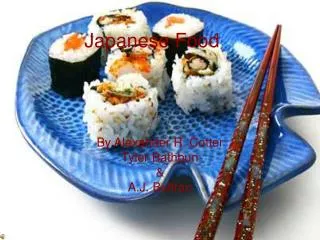
Japanese Food
Japanese Food. By Alexander R. Cotter Tyler Bathbun & A.J. Beltran. Sushi. Sushi is NOT raw fish Its rice. Types of sushi. nigiri sushi ; a hand formed ball of rice topped with your choice of fish or Japanese style egg omelets.
710 views • 13 slides
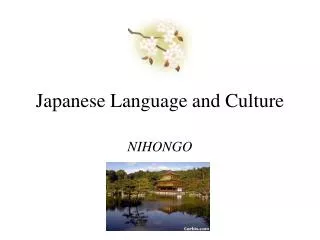
Japanese Language and Culture
Japanese Language and Culture. NIHONGO. History of Japanese Language. Many linguistic experts have found that there is no specific evidence linking Japanese to a single family of language.
2.52k views • 12 slides

Japanese and Japanese culture
Japanese writing system. My name is Yuko Takahashi.It is written as ????also could be written as???? ???also could be written as ???? ??? First one is called Kanji, which is the oldest Japanese writing system adopted in the 6th century when Buddhism was first introduced to Japan from
873 views • 50 slides

JAPANESE CULTURE
CHAPTER 11. JAPANESE CULTURE. Japanese Culture PRISMs. Which are more powerful: goals or ideals? Can people really rise above self-interest to embrace ideals? Is it better to fail doing things the right way than it is to succeed by cutting corners?
1.55k views • 122 slides

JAPANESE CULTURE. JAPANESE FLAG. Japan is below Russia, China, North and South Korea. The island of Japan is almost as big as the state of California in the United States. This is Japan. This is California.
592 views • 18 slides
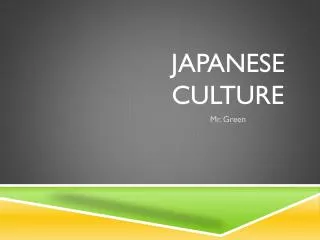
Japanese Culture
Japanese Culture. Mr. Green. Cultural Superpower. Launguage was imported from China Written language is divided into three scripts: Hiragana, Katakana, and Kanji 2 nd Largest music market in the world (Traditional and Modern) . Visual Arts . Painting and Sculpting are main two forms.
427 views • 7 slides

Japanese culture
Japanese culture. Angela adams , Stephanie cheers, pietro christofoli , Emmanuel ayim , kev’ann jarman. Introduction. According to Jones (2012), the 2000 Census found that there were 11,898,828 Asian Americans in the United States 797,700 of which were Japanese American.
935 views • 18 slides

Japanese Food. Antonia Mangos 7Y. Food In Japan . J apanese food is one of kind, no other country has food like theirs. Japanese food is known world wide and enjoyed world wide. There are probably many shops around where you live where you can purchase Japanese foods.
624 views • 8 slides

Japanese Religion and Culture
Japanese Religion and Culture. Buddhism & Shinto. Shinto and Buddhism shaped much of Japan’s culture. These religions affected Japanese art , architecture, novels, and plays. Religion is apart of everyday life in Japan. During the middle ages.
1.08k views • 29 slides

Japanese Culture. By Isaac Shur and Nic Bone. Hierarchy in Japan. Two main classes nobility and peasants Emperor and Shogun- most important nobles. Shogun was main leader, Emperor was puppet figure Daimyos- powerful warlords. Owned and controlled portions of Emperors land
371 views • 12 slides

Japanese Religion and Culture. Shinto and Buddhism shaped much of Japan’s culture. These religions affected Japanese art , architecture, novels, and plays. Religion is apart of everyday life in Japan. During the middle ages.
896 views • 29 slides

Japanese Culture. Warm-up. Question 1: Please look around and tell me where we are. Question 2: Have you ever been to Japan?. Question 3: How can we go to Japan?. Question 4: When it comes to Japan, what kinds of thing will pop up in your mind ?.
991 views • 29 slides
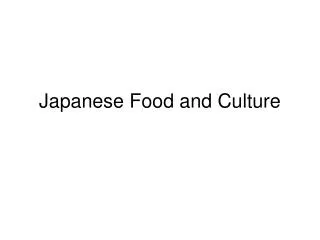
486 views • 27 slides

Japanese Culture. Language/Writing. Hiragana Japanese characters Katakana Japanese phonic characters Romanji - Latin alphabet Kanji - Chinese (traditional) characters. Manga. Naruto Bleach Full Metal Alchemist D.Gray -Man Claymore Detective Conan Death Note Fruits Basket
1.28k views • 16 slides

Japanese Culture. Chatchanee Karnasuta 5080090 Thitinun Danromyen 5080404 SooJung Choi 5080702 Vanussanun Jetchaiyanun 5180134. Background. In East Asia
456 views • 10 slides

JAPANESE CULTURE. JAPAN. Japan is an island . The capital of Japan is Tokyo It’s a very small but a very crowded country. This is the flag of Japan. JAPANESE CLOTHES. The kimono is a traditional clothing. Japanese women and men wear kimonos. There are many different kimono styles.
580 views • 8 slides

Japanese Culture. By Grace Williamson. Shintoism. “Shinto” means “The Way of the Gods”. “神道”の意味は、“神の道”です。. Shintoism is based upon various beliefs: Kami ( かみ ) – the belief of spirits within objects such as animals, plants, rocks, rivers, mountains, thunder, wind, trees, the Sun etc.
456 views • 19 slides

Japanese Culture. Japan is an archipelago in far East Asia The Japanese enjoy the activities that are most valued are the performing arts, visual art, architecture, flower arranging The dominant religions that are practice in the Japanese culture is Buddhism and Shinto
2.54k views • 9 slides

Japanese Culture. Jay Kim. Factor 1: Geographical Isolation. Japan is a group of islands isolated from a mainland so people could not leave whenever they wanted, causing people to learn to live with each other and avoid conflict. Factor 2: Hierarchy.
433 views • 12 slides

Japanese Food. 日本 の しょく. いただきます ( Said at start of meal ). テーブルマナー.
1.23k views • 15 slides
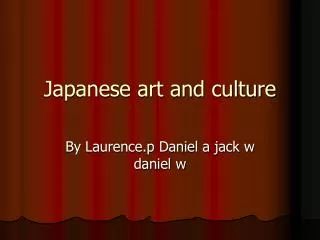
Japanese art and culture
Japanese art and culture. By Laurence.p Daniel a jack w daniel w. manga. Matial Arts.
278 views • 6 slides
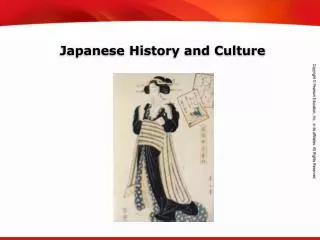
Japanese History and Culture
Japanese History and Culture. Objectives. Explain how geography set Japan apart. Understand how China influenced Japan, and describe the Heian period. Summarize the Japanese feudal system. Explain how the Tokugawas united Japan. Identify how Zen Buddhism shaped culture in Japan.
745 views • 22 slides

Moritsuke: The Japanese Art of Food Plating
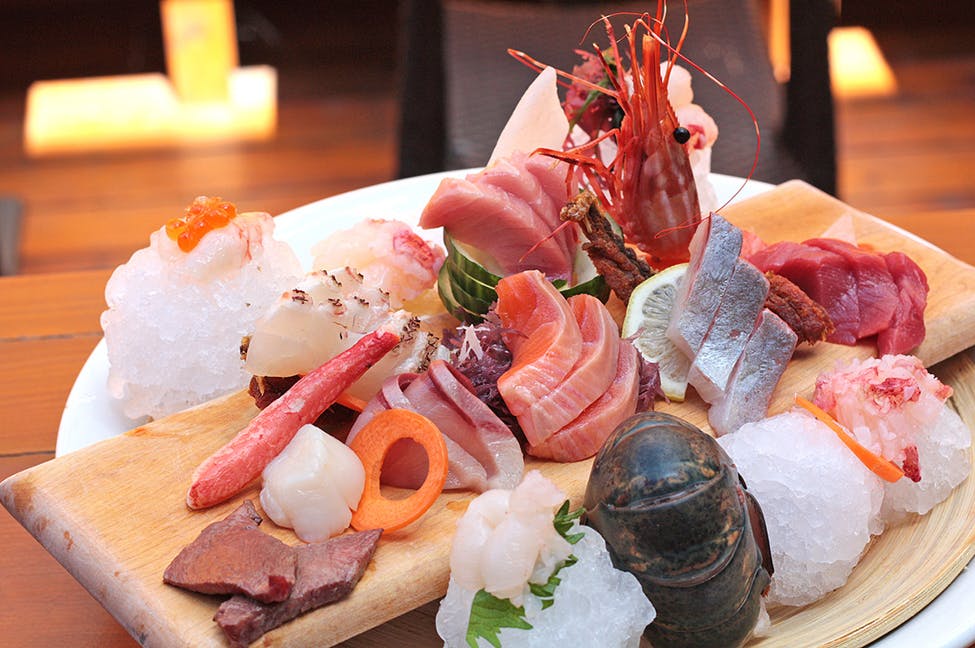
Relish in the exquisite and complex beauty of moritsuke where food becomes art.
The Japanese art of food arrangement, moritsuke, is a beloved practice that has been passed down from generation to generation. It is the interplay of tradition and the present moment, space and possibility, intrigue and calmness. Focusing on seasonality, servingware, empty space, and arrangement, moritsuke is a delicate art with the goal to achieve harmony on every plate.
Seasonality
In Japanese cuisine, emphasis is placed on the season and the food it brings. From the details on the servingware to the colour schemes, every aspect of a dish reflects the allure of each season. For example, find pinks, greens, and cherry blossoms on your plate during the spring, and pine, bamboo, and plums in the winter. For autumn, reds, golds, and maple leaves will make an appearance alongside mushrooms and daikon radish.
Servingware
When serving traditional Japanese food, every plate and bowl is carefully considered to accentuate the qualities of the dish it serves. The artistry of Japanese servingware is that no two dishes have to be alike. Each dish can be a different shape, size, colour, and material with various decorative patterns. Despite the asymmetry, the result is a stunning and unique masterpiece.
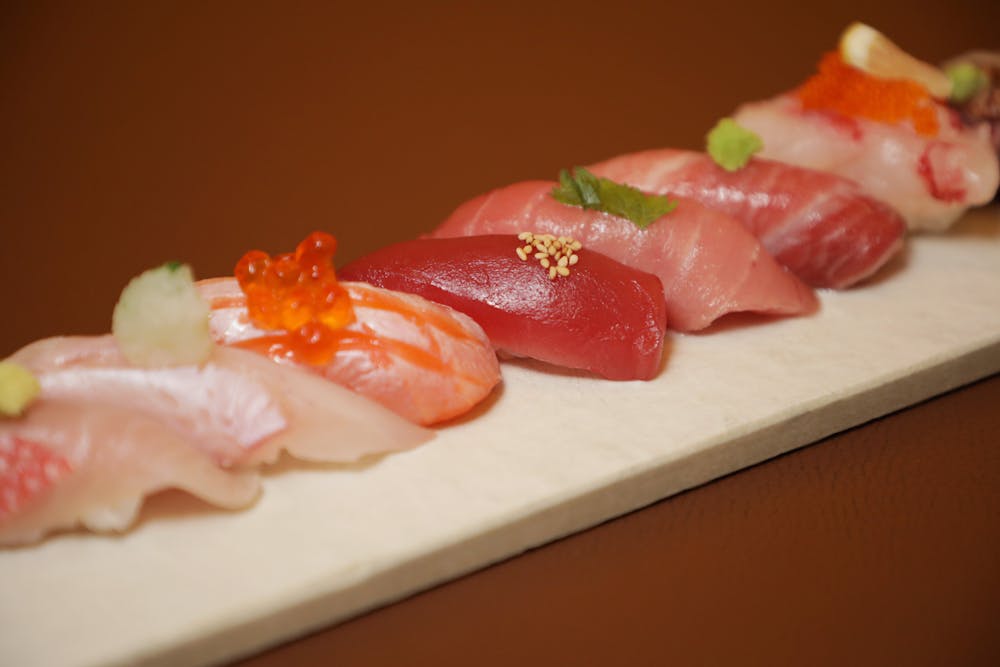
A close-up of our Nama sushi dish topped with colourful and delicious garnishes.
Empty space
From minimalist interior designs to traditional paintings, the Japanese concept of empty space, ma, can be found throughout Japanese culture. In dining, plates are never piled high with food or fully covered. The empty space helps the eye focus on the meal in front of them, creating a sense of intrigue and possibility.
Arrangement
Japanese food arrangement is guided by a set of key principles and rules to ensure every dish is as beautiful as it is delicious. Some of the most common arrangements include yama no katachi, which is to arrange food in a mountain-like display, and sugimori, to shape food like a conical cedar tree. The most difficult technique to master is chirashimori, which is to place food in a scattered arrangement while still achieving balance and refinement.

Our Lobster Platter is arranged delicately to showcase the various colours and textures of the sashimi.
At JaBistro, our sushi and sashimi is plated with intention and care to enhance the harmony of flavours and colours. Book your table today to experience authentic Japanese sushi and sashimi.
Email Signup
Reservations.
Got any suggestions?
We want to hear from you! Send us a message and help improve Slidesgo
Top searches
Trending searches

34 templates

32 templates

31 templates

28 templates

16 templates

35 templates
Japanese Food Agency
Japanese food agency presentation, free google slides theme and powerpoint template.
Are you a Japanese food provider or distributor? That's great! Restaurants that serve Japanese food are becoming more and more popular worldwide. Do you want to tell your audience how you operate? Or perhaps you want to market new products with style? We have this very thematic template for you, whose illustrations and graphic resources will be like an appetizer for your audience. Two sushi, please!
Features of this template
- 100% editable and easy to modify
- 22 different slides to impress your audience
- Contains easy-to-edit graphics such as graphs, maps, tables, timelines and mockups
- Includes 500+ icons and Flaticon’s extension for customizing your slides
- Designed to be used in Google Slides and Microsoft PowerPoint
- 16:9 widescreen format suitable for all types of screens
- Includes information about fonts, colors, and credits of the free resources used
How can I use the template?
Am I free to use the templates?
How to attribute?
Attribution required If you are a free user, you must attribute Slidesgo by keeping the slide where the credits appear. How to attribute?
Related posts on our blog.

How to Add, Duplicate, Move, Delete or Hide Slides in Google Slides

How to Change Layouts in PowerPoint

How to Change the Slide Size in Google Slides
Related presentations.

Premium template
Unlock this template and gain unlimited access

Watch CBS News
A look at the White House state dinner for Japan's prime minister in photos
By Kathryn Watson
Updated on: April 11, 2024 / 9:37 AM EDT / CBS News
A spring-themed menu inspired by American and Japanese cuisine and decor evocative of a koi pond were all features of Wednesday night's White House state dinner honoring Japanese Prime Minister Fumio Kishida and his wife.
President Biden and first lady Jill Biden recognized the long alliance between the United States and Japan with the rare, time-honored tradition of a state dinner that draws from the traditions of both countries.
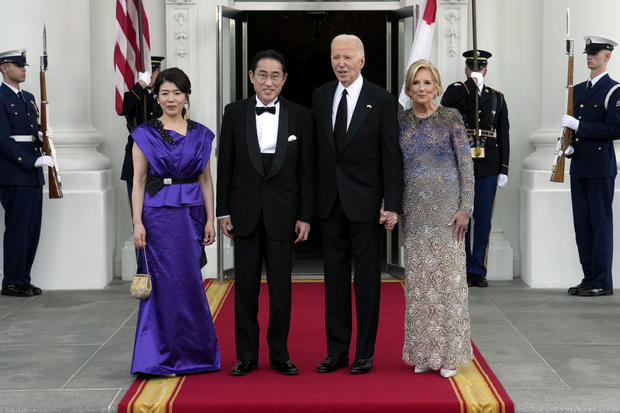
Singer-songwriter Paul Simon, who counts both the first lady and the prime minister as fans, performed.

Former President Bill Clinton, former Secretary of State Hillary Clinton, actor Robert DeNiro, and billionaire Jeff Bezos were all on the guest list.
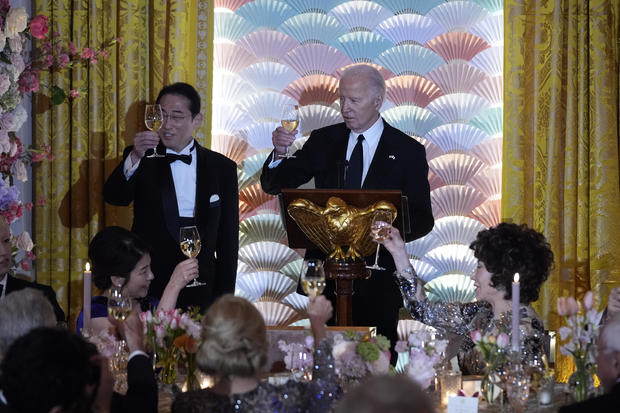
The theme and decor
The theme was "celebration of spring," a symbol meant to mirror the friendship between the two countries. A garden displayed blooms native to both nations, including sweet peas, peonies and hydrangeas. Glass and silk butterflies appeared on the dinner tables, too.
The starring element of the decor for the dinner was the floor, covered to make it appear as if guests are walking over a koi pond with lily pads and cherry blossoms. The colors green, blue and pink were central to the theme — green to represent the growth of friendship, blue to represent stability and security and pink to represent spring's essence.

The food is the center of any good state dinner. According to the White House, guests were served a first course of house-cured salmon; a salad of avocados, red grapefruit, watermelon radish and cucumber; and shiso leaf fritters.
Dry-aged rib eye steak with blistered shishito pepper butter, fava beans, morels and cipollini was the main course, with a sesame oil sabayon.

Dessert included salted caramel pistachio cake, a matcha ganache; and ice cream — cherry ice cream, with raspberry drizzle.

The evening's wines were from Oregon and Washington.
From Hollywood celebrities, to billionaires, to key political allies, the guest list was exclusive.

- Fumio Kishida

Kathryn Watson is a politics reporter for CBS News Digital based in Washington, D.C.
More from CBS News

Assange's wife takes hope as Biden suggests U.S. could drop charges

Biden administration announces plans to expand firearms background checks

Key players to know in Trump's "hush money" trial, set to begin Monday

Rising numbers say Biden should encourage Israel to stop Gaza actions

IMAGES
VIDEO
COMMENTS
Japenese Cuisine. This document provides an overview of a presentation on Japanese cuisine. It begins with an introduction to Japanese cuisine, noting that it is based around rice and seafood. It then discusses the history of Japanese cuisine, including influences from Korea and China in introducing rice, soybeans, and other staples.
In Japanese food culture, there are three types of noodles: udon (うどん), soba (そば) and ramen (ラーメン). Udon noodles are made from wheat flour. They are served either hot or cold, depending on the season. Toppings like raw egg and tofu can be added to an udon dish. Soba noodles are made from buckwheat.
• China had a strong influence on Japan's food culture o However, Japanese food preparation and presentation is unique! • Their reverence for harmony within the body and community and with nature has resulted in a cuisine offering numerous preparation methods for a limited number of foods. • Each item is to be seen, tasted, and relished.
1. Keep in mind the three rules of threes. Red, yellow and green are key colors in Japanese cooking. Getting a nice balance of all three in your presentation will make the food look appealing and bright. In addition, a triangular (three-sided) composition on the plate looks nice and catches the eye. Think about how sashimi is served.
Japanese food preparation and presentation. Part of what makes Japanese food culture unique is the attention given to cooking and presentation techniques. It's not enough to have fresh and delicious ingredients — they also have to be cooked well and presented in a visually appealing way. 12. There are five cooking methods in Japanese cuisine.
When it comes to food presentation, the Japanese are experts. From super kawaii (cute) character bento boxes to luxurious ¥30,000 sushi courses, it's safe to say people place great importance on looks. However, I don't know about you but the word isogashi (busy) fittingly describes my life in Japan. So when it comes to food presentation ...
The rice-centered food culture of Japan evolved following the introduction of wet rice cultivation from Asia more than 2,000 years ago. The tradition of rice served with seasonal vegetables and fish and other marine products reached a highly sophisticated form in the Edo period (1603-1867) and remains. the vibrant core of native Japanese cuisine.
In practice, modern kaiseki is actually a style of cooking and food presentation that evolved over the last few centuries, bringing together a wide variety of high-end cooking techniques, presentation methods and ingredients. The best description of kaiseki is simply "Japanese haute cuisine," that is, elegant food eaten on special occasions.
Another name for Japanese cuisine is "Washoku" 和食, where 和 means 'Japan' or 'harmony,' 食 means 'food' or 'to eat.'. As implied in the kanji (漢字; Chinese characters), Washoku harmoniously blends the ingredients for a nutritious and beautifully presented meal. The key features of washoku include:
In conclusion, Japanese food presentation is a true art form that emphasizes minimalism, balance, and harmony. By incorporating the principles and techniques of Japanese cuisine into your own cooking, you can elevate your dishes to a whole new level. Remember to focus on simplicity, negative space, color, texture, and shape.
The technique of deep frying is not native to Japan; the Europeans and Chinese first introduced it. The classic deep-fried Japanese food Tempura (天婦羅) originates from the Portuguese in the Muromachi era (1336-1573). Deep frying may seem simple, but it's a fine art that requires perfect control of the amount of oil, temperature, and batter.
One style of Japanese food presentation that has remained relatively untouched by time is shoujin ryori. Shoujin can be translated as "devotional" because this is the style that has been handed down in Buddhist monasteries and temples through hundreds of years. Of course it is strictly vegetarian, but the lack of meat by no means makes it dull.
Japanese food has been gaining in popularity all over the world, and with the induction of traditional Japanese cooking, or "washoku," as a UNESCO Intangible Cultural Heritage, locals are expecting interest to rise further. ... Getting a nice balance of all three in your presentation will make the food look appealing and bright. In addition, a ...
Here are some popular components in Japanese meals. Rice: Rice is a staple of the Japanese diet. People use it in a wide range of dishes, namely sushi, donburi bowls, and onigiri (rice balls). Seafood: Japan is surrounded by water and has a long history of fishing, so seafood is a major part of natives' meals.
In Japanese culture, presentation is an essential aspect of food. Bento boxes , a popular lunch option in Japan, are an excellent example of this attention to detail. These aesthetically pleasing meals often consist of small compartments filled with rice, fish or meat, and vegetables.
The Japanese art of presenting food, moritsuke, was the subject of Elizabeth Andoh's lavishly-illustrated presentation at the serene Globus washitsu. American-born Andoh has made Japan her home for more than 50 years and is a leading authority on Japanese culinary culture. She approached moritsuke by identifying three elements that govern the ...
Presentation takes keen importance for chefs in Japan as it aids to the entire artistic experience of the dining culture. Everything from the shape of the food to the size of the ingredients plays a role in building flavor while uniformity, texture, and color aid to the overall appearance.
Here are the basic rules of Japanese food presentation followed in the kitchen of your favorite Japanese restaurants: 1. Asymmetry and balance. While Western foods are presented on round plates and food is plated with symmetry in mind, Japanese food is served on plates and bowls of varying shapes and sizes. The art of the dishes makes use of ...
Japanese gastronomy has many other typical dishes, such as okonomiyaki, ramen, miso soup, teriyaki... With this template you can present all these delicacies and more in your Japanese street food workshop. Its modern geometric style design has the perfect combination of text and images, so you can explain everything about this type of food in a ...
Presentation Transcript. Japanese Food and Culture. The Island of Japan. The Meal (gohan) • Two Kinds of Food: • 'Staple' and 'Other dishes' • Staple (gohan) is rice • Other dishes (okazu) are fish, meat, vegetables. Traditional Concept of Meal • Neutral flavor of rice considered complement to meal • Fill up on gohan, okazu ...
Sushi is a Japanese food that is gaining more and more popularity every day. For this reason, inspiring your marketing presentation with this popular food will give it a very fresh and modern touch. Slidesgo has designed this multipurpose template for you to use for any marketing-related presentation - how...
The Japanese art of food arrangement, moritsuke, is a beloved practice that has been passed down from generation to generation. It is the interplay of tradition and the present moment, space and possibility, intrigue and calmness. Focusing on seasonality, servingware, empty space, and arrangement, moritsuke is a delicate art with the goal to ...
Tags. Red Modern Marketing Illustration Agency Food Sushi Asia Japan. Get ready to market Japanese food in your own country with the help of this editable template for Google Slides and PowerPoint.
Biden, Japan's Kishida hold press conference with focus on China 38:59. ... The food is the center of any good state dinner. According to the White House, guests were served a first course of ...